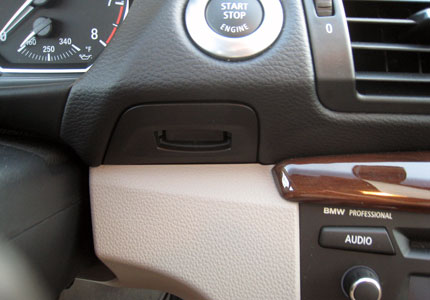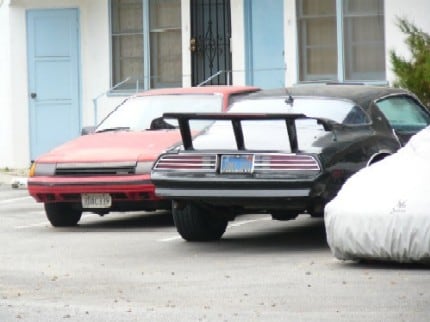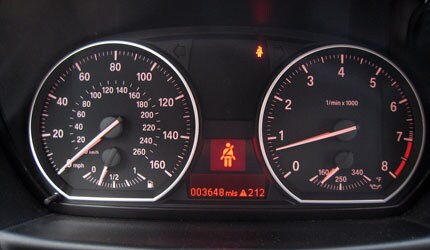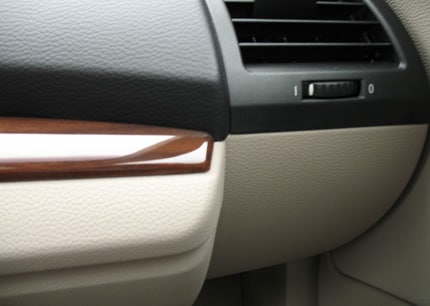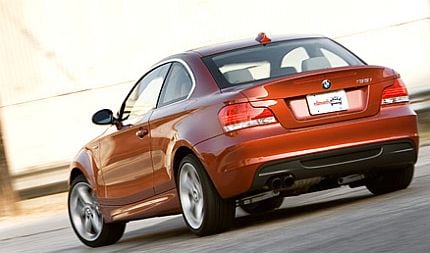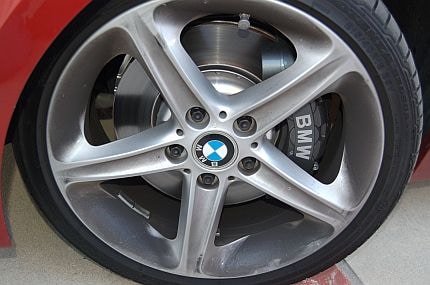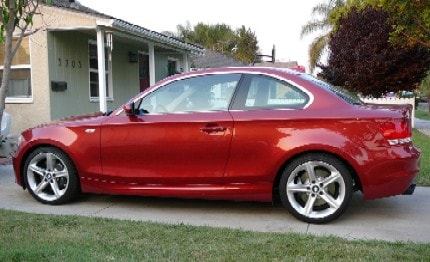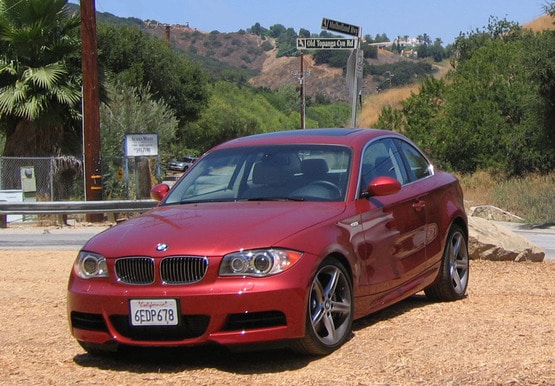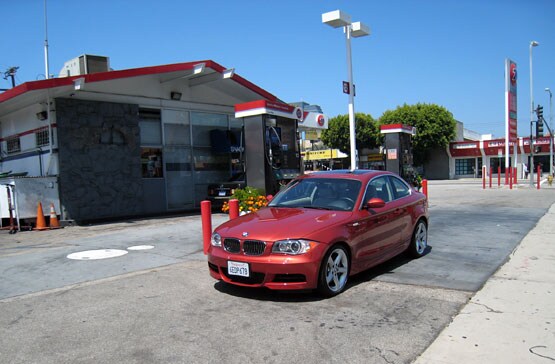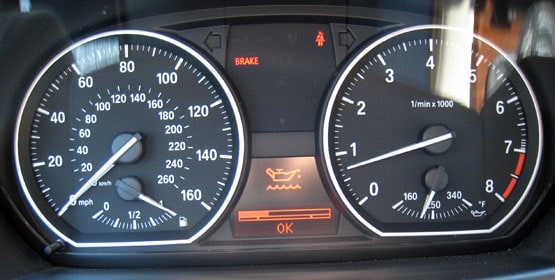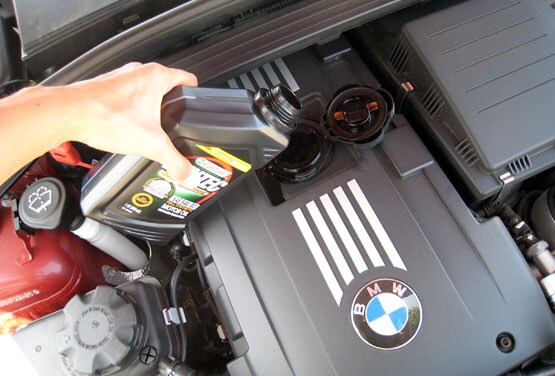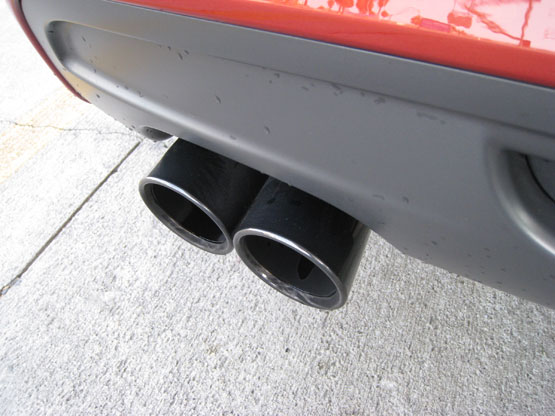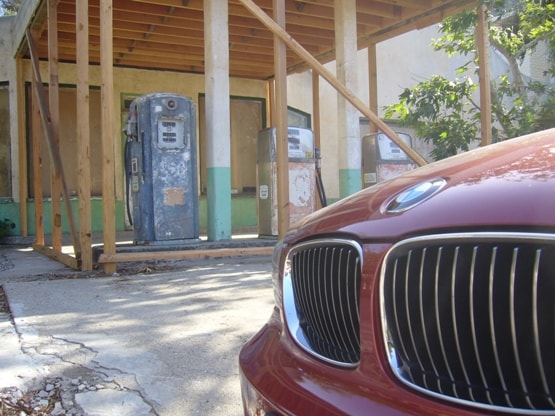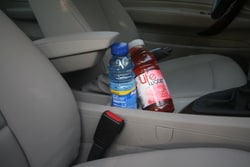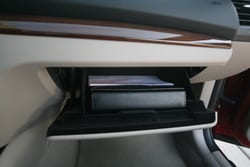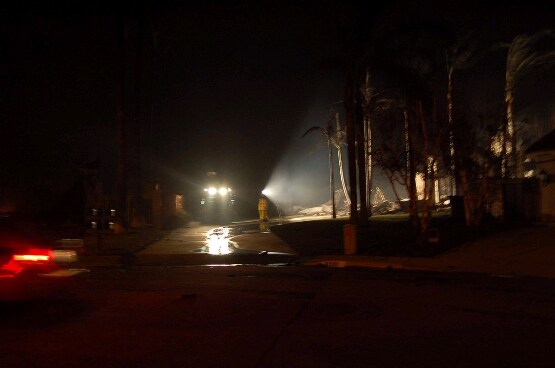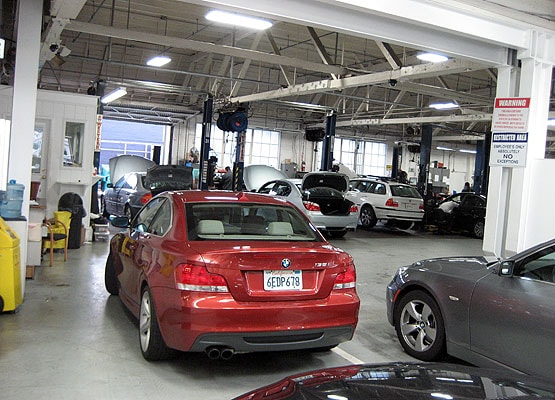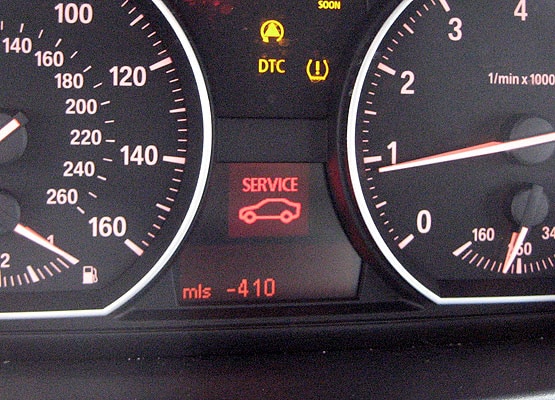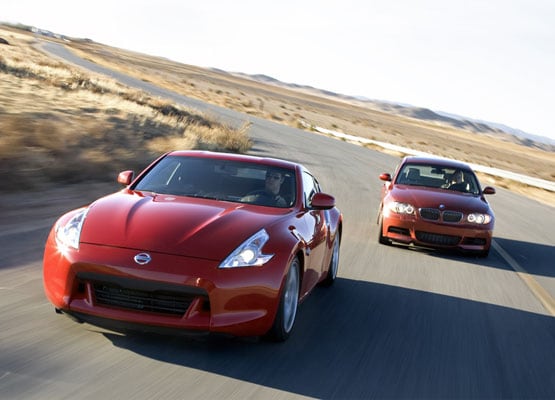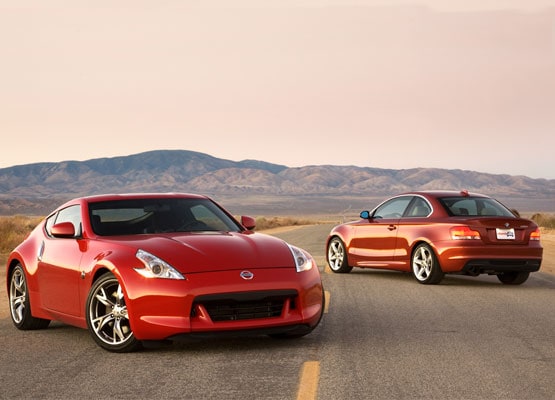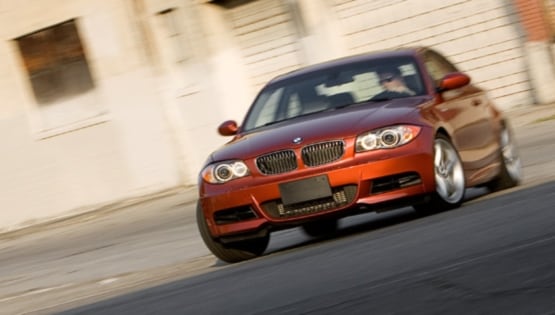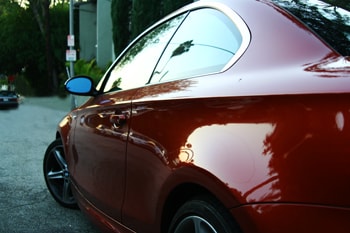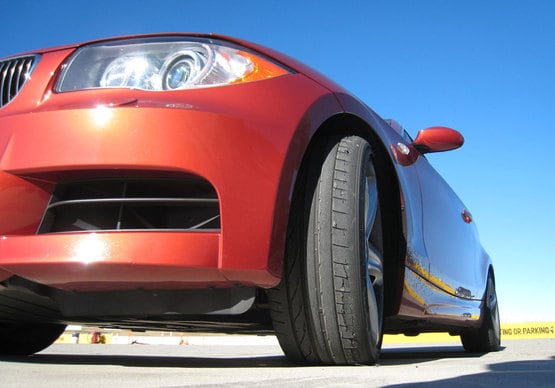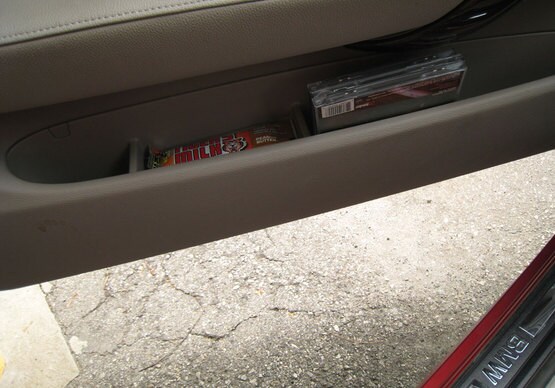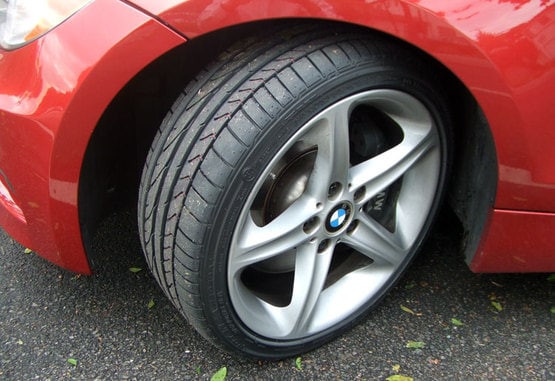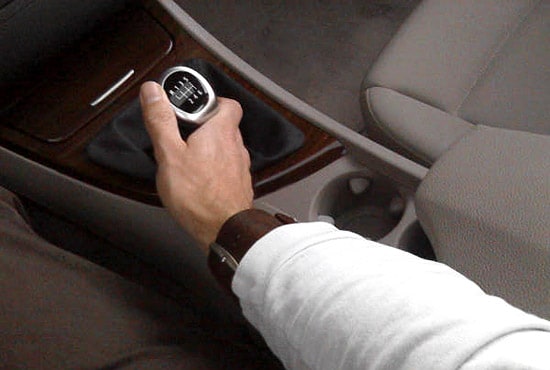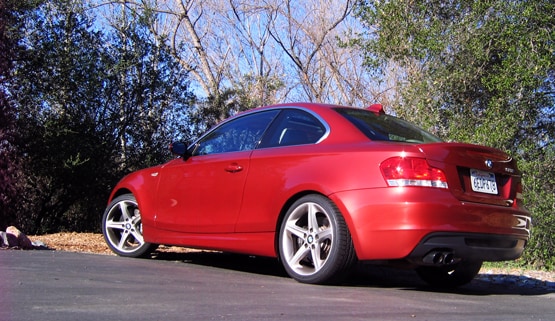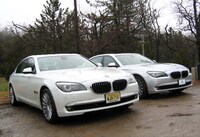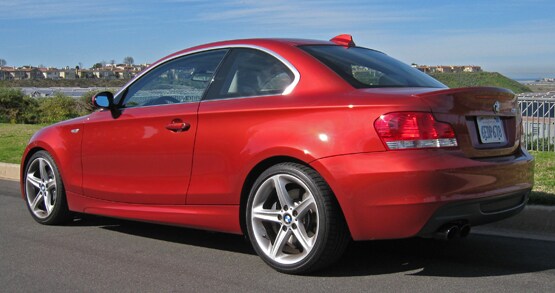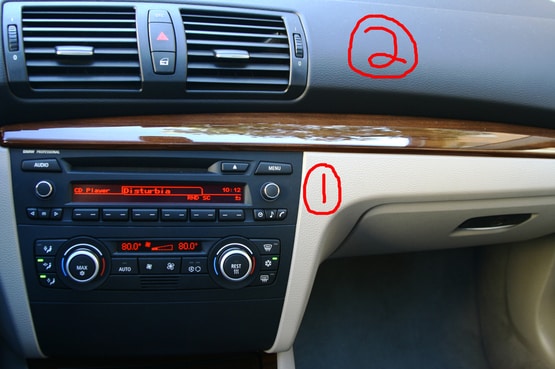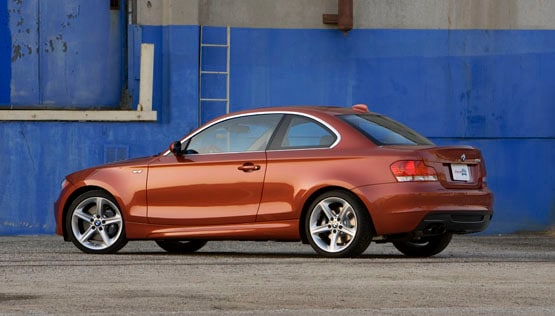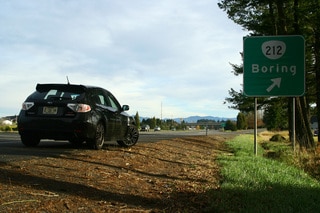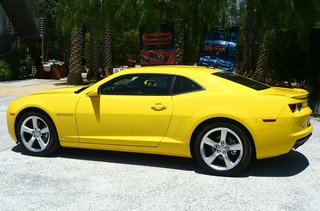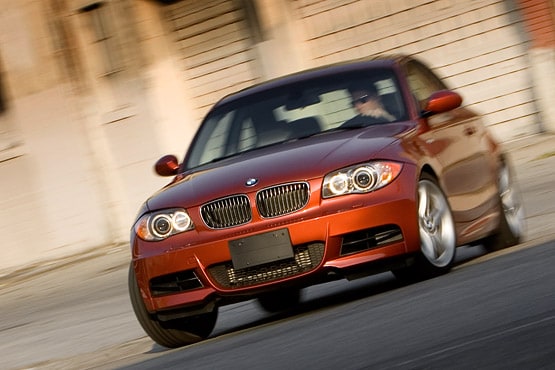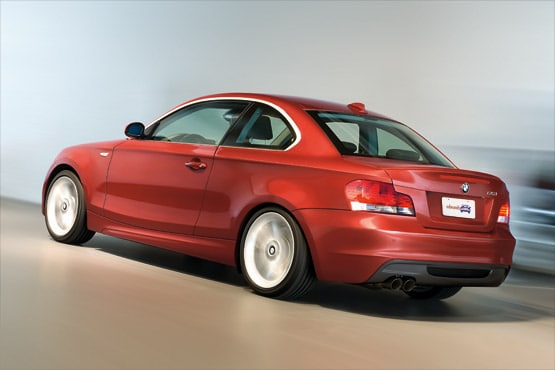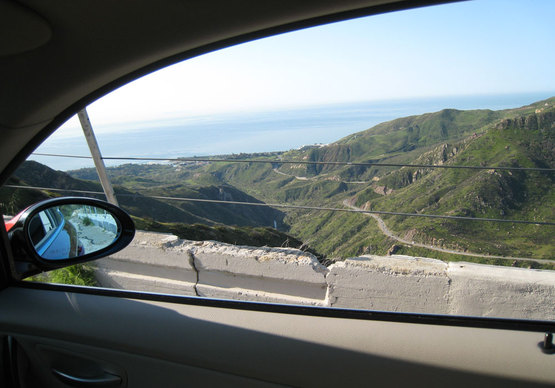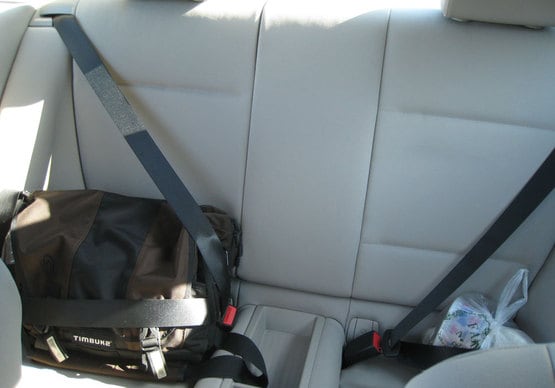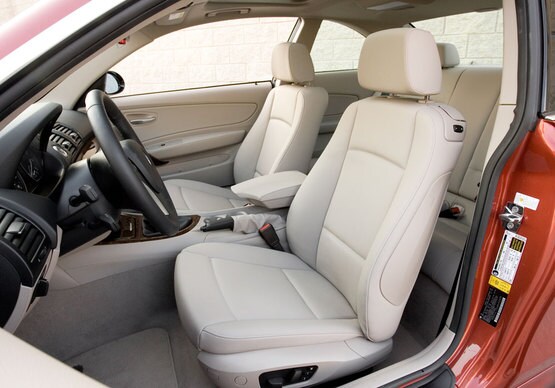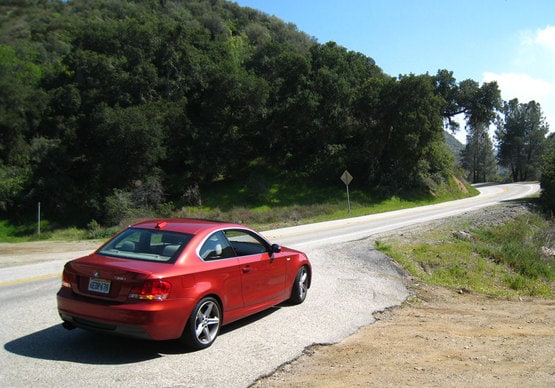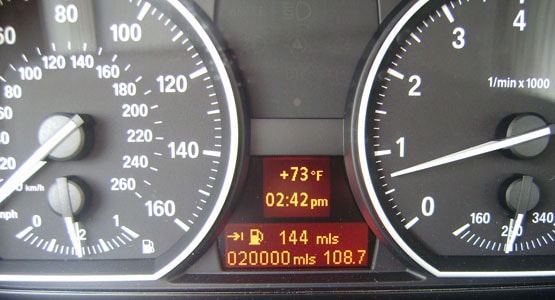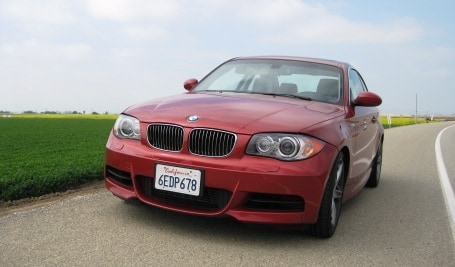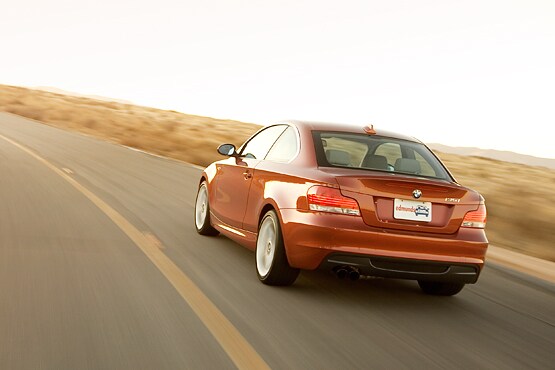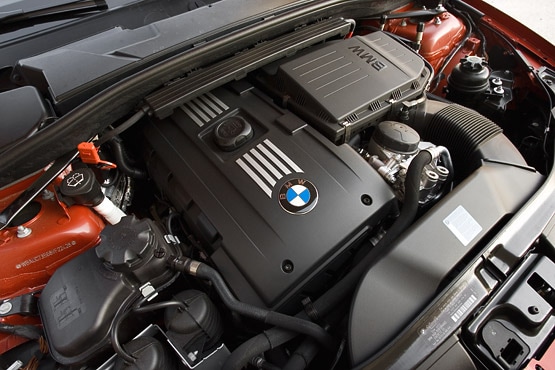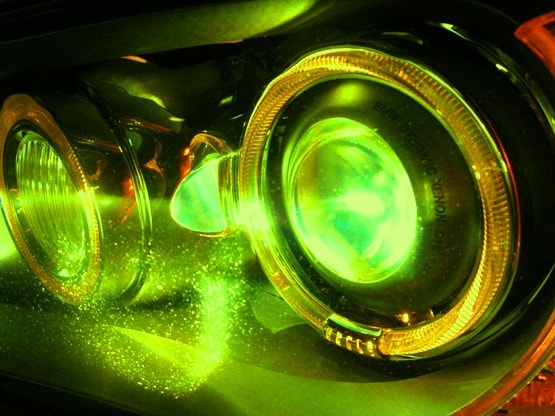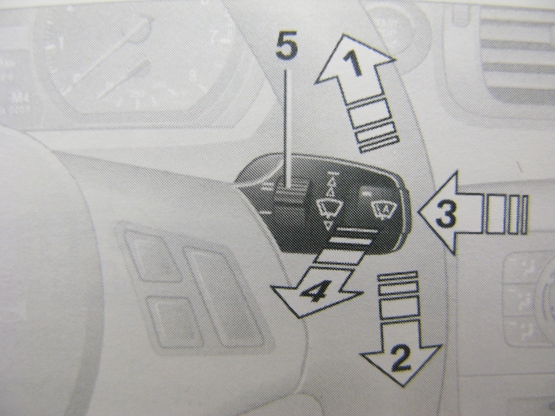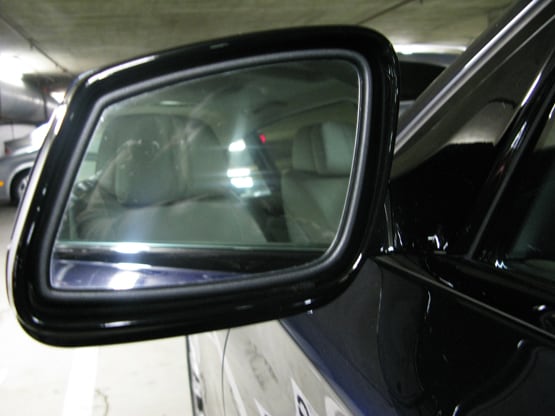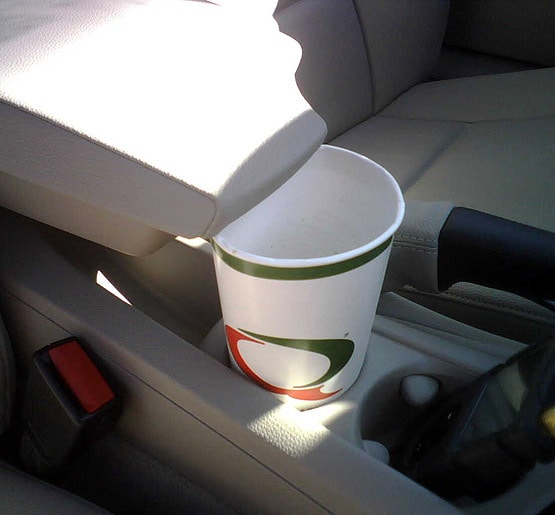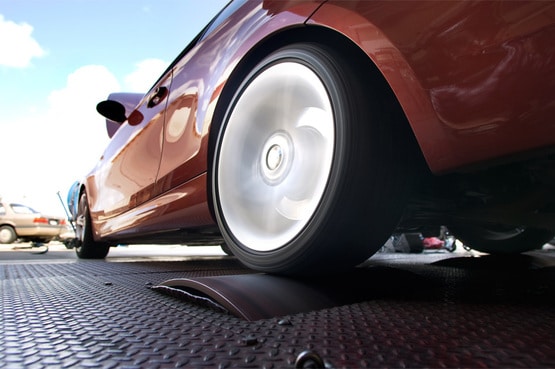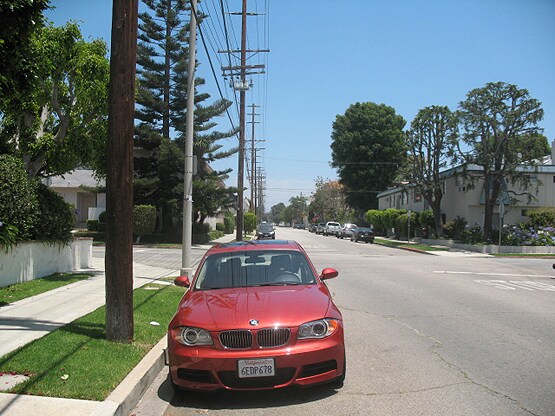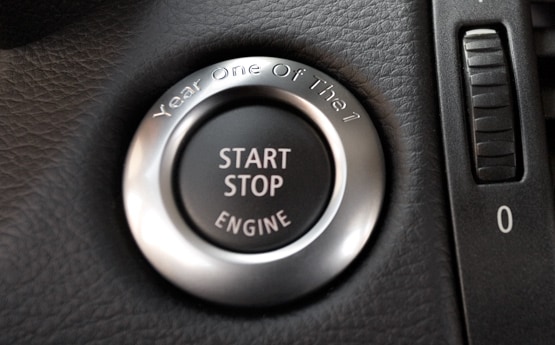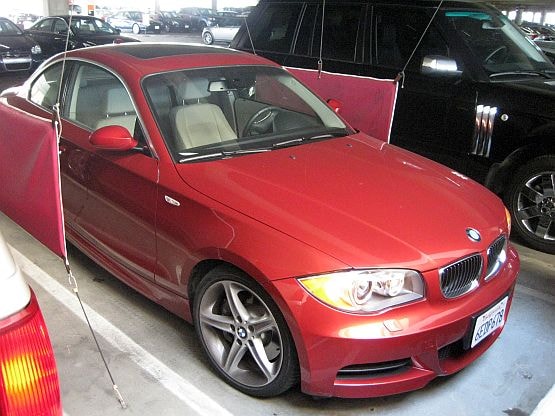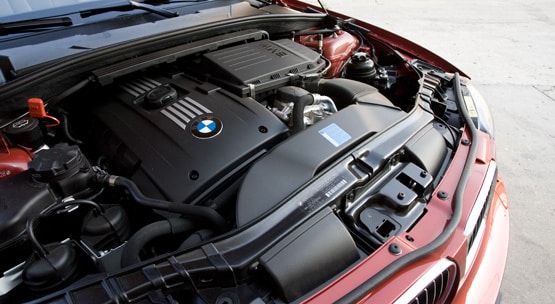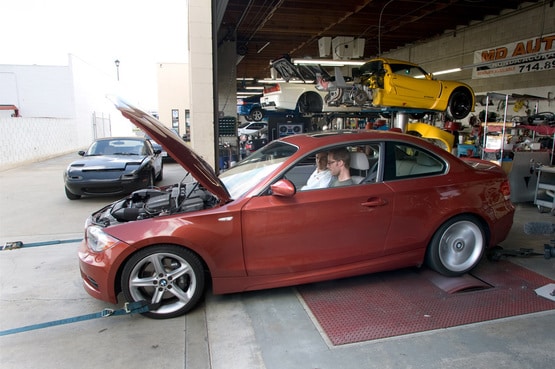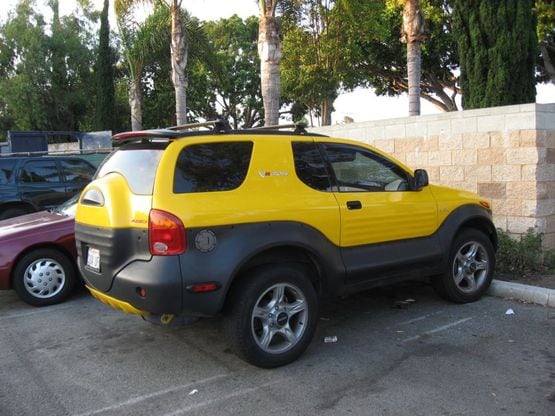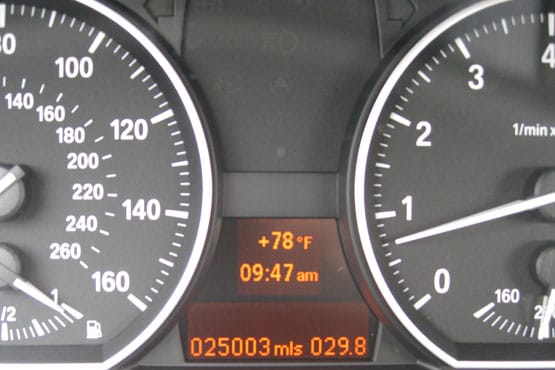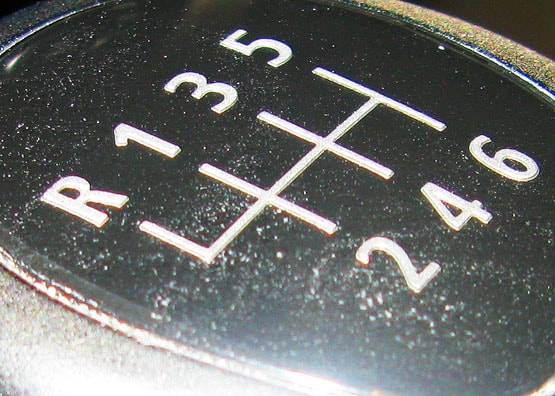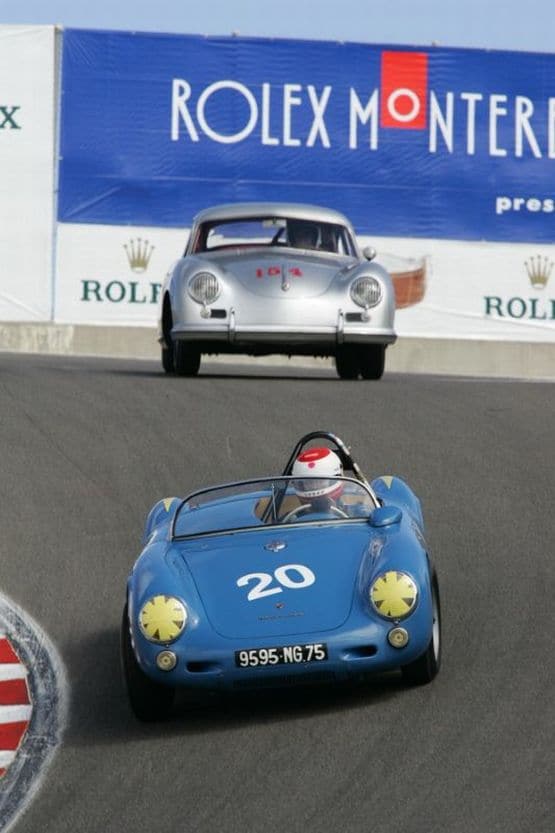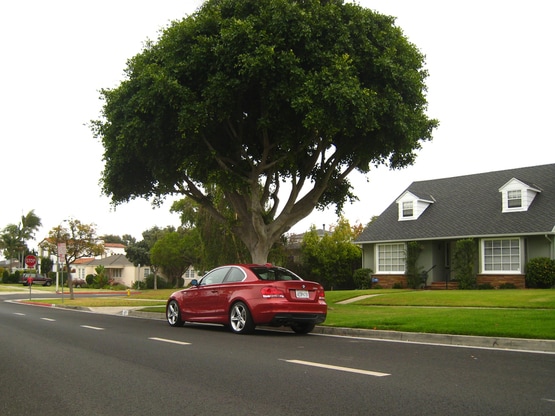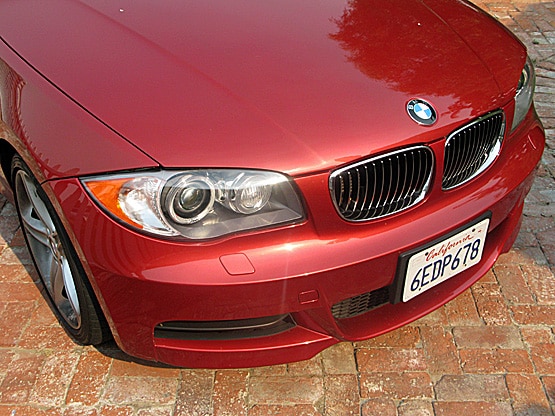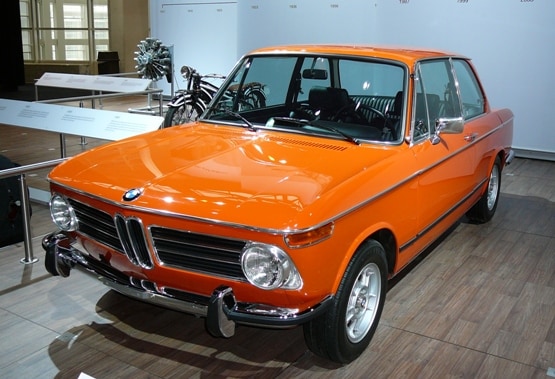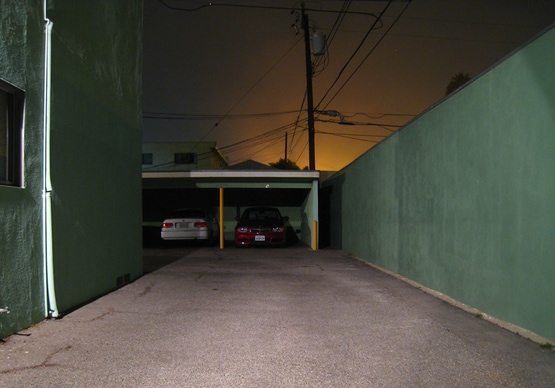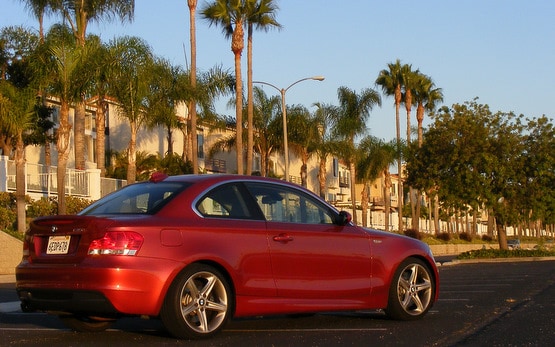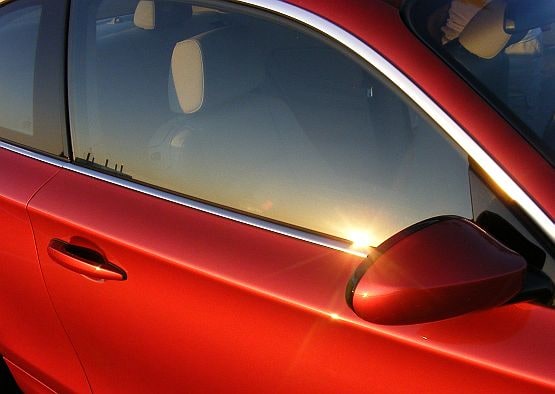2008 BMW 1 Series: What's It Like to Live With?
Read the latest updates in our long-term road test of the 2008 BMW 1 Series as our editors live with this car for a year.
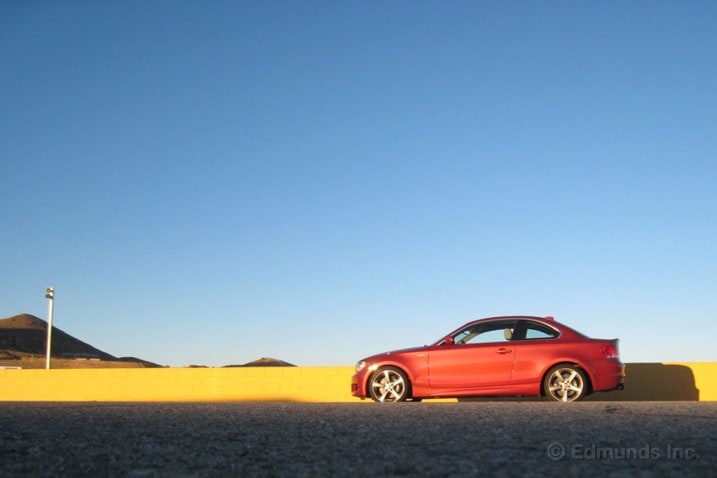
What do you want to know about?
- Introduction
- Not Every Detail is Perfect
- Get the Sport Seats
- Did I Say That?
- Not Bad
- The 1 does 2+2
- Merciful Warning Chimes
- Mileage Update
- Coming Up a Bit Short
- Oh Yeah!
- It's Not All Wonderful
- Symmetry Gates
- Now THAT'S a lot of motor
- Fuel consumption and handling update
- Do You Really Want the Bigger 6?
- An Audrina Patridge of Automobiles
- Santa Barbara Road Trip
- Not Much Fun for a Boring Driver
- Deflated
- Ain't no shame in havin' a small one
- Attention to Detail...It Matters
- Road Trip and Fuel Mileage Update
- Interior Storage
- Battery Location
- Junior M3
- Fast Times... and Run-Flat Tires
- Brake Dust — It's a Way of Life
- Crouching Tiger Hidden Motorcycle
- Burnt Ember
- Gathering a Crowd
- Attracting All the Wrong People
- Everything but the radio
- Torrential Rain? Time to Check the Oil.
- Service With A Smile
- Better than a 2009 Nissan 370Z?
- Holiday Warmth
- Not Interested
- Lighting Up the Corners
- Track Day at Big Willow
- Change of Heart on the Track
- Storage Bins, MPG, Wind Noise, Mundane Observations
- Track Days are Never Cheap
- Postcard From L.A.
- Don't Impugn My Love You Lobster-Eater
- 2008 BMW 135i or 2002 BMW M3 E46?
- Spoiled by the N54 or; Why I wouldn't buy an E46 M3 or; Why Sadlier is off his rocker.
- Underhanded
- From the Big Daddy to Baby Bimmer
- Breaking in and breaking out
- Interior Design and Quality, or, BMW Qua Star Pupil
- It Has Baggage
- Learner's MT
- I Can Sit Behind Myself!
- Textcast — The One Against The World
- Cruise Paddle a Dying Breed?
- Open Thread
- Stonk Fast
- Editor Almost Complains About Tractable Torque
- Is the Backseat Better Than the Driver Seat?
- Better With CAKE
- You Choose Whether the Mirrors Tilt Down in Reverse
- Video Walk-Arounds
- Sunday Afternoon in Little Tujunga Canyon
- 20,000 Miles and Running Stronger Than Ever
- Excellent Headlights
- Sideview Mirror Malady
- Untapped Potential
- DME Tune Reflash
- Do it. Do it now!
- Reflashing Is Yummy; DME Tune, Part II
- Testing The DME Tune Reflash
- Thoughts on the Reflash
- Little Brother Goes Topless, Tackles Mini
- DME Tune Reflash Driving Impressions
- Activating Intermittent Windshield Wipers 101
- Objects in the Mirror Are ?? Than They Appear
- Don't Drink and Drive
- Full-on Dyno Comparison Geek-out
- BMW Doesn't Fix What Isn't Broken
- Even Better
- Nervous Tummy
- Better Steering Than the 7 Series
- Going In For Service Soon
- Chillax
- The 15-second Crank
- Hiccup Free
- Speed Limiter
- Ugly?
- 25,000 Miles of Ownership
- How To Resist Temptation
- Plus One Quart of 5W30 Synthetic
- Pre-Historic
- Something's Not Right About the Ride
- Doing the Numbers
- Needs Another Door Grab
- Spiritual Sucessor?
- It Defines Effortless
- Fun, Fast, Refined and Dead Reliable
- Looking for a New Owner
- Sales Update — Tire Kickers Galore
- Farewell to an Outstanding Car
- Wrap-Up
Introduction
When the BMW 1 Series first looked like it would be brought to the U.S. from its successful home in the European market, we had visions of a return to the BMW 2002, the car that really invented the BMW brand in America back in the late 1960s. It would be a return to form, an expression of the true BMW spirit. You know, something small, light, nimble and affordable. We even dared to dream of a reborn BMW 2002 tii.
But then the specifications hit our desk with a thump. It turned out the BMW 1 Series would be heavier than we expected, not to mention more expensive. Fortunately it would be more powerful, too. It became clear to us that the 1 Series was not so much a continuation of the beloved 2002, but rather a rebirth of the 3 Series.
If you haven't noticed, the BMW 3 Series has, well, expanded. Those who hit the upper-middle-class running in the go-go 1980s bought a far different 3 Series from the one we enjoy today. It was small, light, nimble and affordable. It was a gateway car, an introduction to the brand — a broker's first BMW, you could say. BMW hoped as its new customers climbed the corporate ladder, they would steadily upgrade their BMW to suit. Have a family, buy a 5 Series; make partner, buy an M6. Retirement imminent? You, sir, need a 7 Series.
But then the BMW 3 Series became a mass-market success and soon it acquired a mass-market identity, morphing into a vehicle that is all things for all people. It's a coupe, sedan, convertible, wagon and even a sport-utility if you count the X3, and there are gasoline engines, diesel engines, four-cylinders, a twin-turbo inline-6 and now even a V8. Once you're behind the wheel of a BMW 3 Series, there's very little need to move up.
Which brings us back to our newest long-term test car, a 2008 BMW 135i. When you compare the specifications, the 1 Series is not so different from the 3 Series: a fraction shorter, a fraction lighter and really only a fraction less expensive. It's smooth, sophisticated and as carefully optioned with consumer-friendly convenience features as a 3 Series.
If we wanted a 1 Series more like a BMW 2002 tii — something in the spirit of cheap and cheerful, only with terrific speed — it was clear we would have to build our own.
What We Bought
At $28,600 the 2008 BMW 128i is the least expensive new BMW you can buy in the USA, but it's missing something for us. Something with a little more kick. Something with a pair of turbochargers. Something, oh, like the twin-turbo, 300-horsepower 3.0-liter inline-6 that currently resides in the latest BMW 335i and BMW 535i. This is an engine so sweet that it seduces us no matter where BMW puts it. And we're not alone, as this engine has been awarded top honors in the 2008 International Engine of the Year competition.
Of course, as soon as you tick this box on the order sheet for a 1 Series, you take a $6,300 hit to the wallet. But don't think you're paying $6 grand for the engine alone, as the upgrade to a 135i includes a sport-tuned suspension, 18-inch wheels with summer-only performance tires, and six-piston fixed calipers for the front brakes. The 135i also includes an aerodynamic body kit inspired by BMW's high-performance M-cars.
So we spent the money.
And even though we were already cheating on our plan to create a modern 2002, we still wanted to remain true to a pure spirit of performance, so we kept the options to a minimum. Only Porsche makes this process tougher than BMW, however. Days and then weeks slipped by as we called and e-mailed and called again, looking for a stripper 135i. None to be had, no matter where we looked in the country. At one point, it looked like our best alternative would be a 135i with an automatic transmission and enough dealer-installed accessories to bust the $45K barrier.
But then we found the right car right in our own neighborhood. Rusnak Westlake BMW (Buy a car there? Rate it!) in Thousand Oaks, California, had a 2008 BMW 135i equipped with a six-speed manual transmission right on its lot (true believers in the 2002 tii!). No premium package and only one indulgence: power front seats.
Unfortunately this item added $995 to the tally and kept us from the 1 Series sport seats that had captured our attention in our full test of the 135i. As Director of Vehicle Testing Dan Edmunds says, "The package also includes terrific eight-way manually adjustable seats that adjust quickly, hold on tight in corners and look great. Why spend the money for optional power seats?"
Well, you buy them because you have to. It was that or wait months for a custom-built 1 Series to be shipped from Germany.
What Kind of BMW Is This?
Did you catch our recent all-BMW comparison? We pitted our long-term 2002 BMW M3 against a 2008 BMW 335i and a 2008 BMW 135i in daily life, on back roads and at the track to see which would come out on top. The winner?
No, not the 335i — too big, too expensive and too slow. Instead, the numbers on the scoring sheet recorded a tie between the 2008 BMW 135i and the aging yet still potent E46 M3. A tie! A hopped-up version of BMW's cheapest car not only keeps up with one of the finest BMW performance cars ever built, but also outpaces it in several respects.
And so we're persuaded that we have the right 1 Series in our long-term test fleet. Apart from storage space, is there a downside to the basement BMW with such compelling performance credentials? Is this the BMW 2002 tii we long for, or just a BMW 3 Series in disguise? How about that styling? We have 12 months and 20,000 miles to find out.
Current Odometer: 2,082
Best Fuel Economy: 24.0 mpg
Worst Fuel Economy: 19.1 mpg
Average Fuel Economy (over the life of the vehicle): 21.4 mpg
Edmunds purchased this vehicle for the purposes of evaluation.
So our 135i drives great. Flawless engine, smooth shifter, blah, blah, blah. Lets get to the real important stuff. Are you seeing that dash trim?.. Doesn’t really fit right does it? Sure, it’s on there good and tight, but clearly it was designed for another dashboard. Can’t blame BMW for reusing a few parts to keep costs down, but maybe it should have picked a piece of trim that wasn’t right in the driver’s line of sight. It looks shoddy, and when you just dropped $37K on a new coupe that’s not good.
Opting into our long-term BMW 135i for a trip to Sequoia National Park over the holiday weekend was a smart choice. Yeah, there's all the boring stuff like it's easy to park and snaps through traffic like a squirrel, but the more compelling reason is that the park's foothills offer roads from a driver's dream — switchbacks, sweepers and mercifully little traffic.
This is one well-rounded car. On the boring freeway slog, the 135i was relaxed and quick. Exploiting the quickness on the fun roads, however, revealed that these seats offer hopelessly inadequate lateral support... When I flung the 135i through the first fast turn, I may as well have been sitting on bench. The seat comfort is good, but what is this, a Buick? Don't even consider the non-Sport Package seats if you have any intention of ever driving this car hard.
I'd like the suspension to have a bit more compression travel, too, as the bumpstops got a solid whack a few times. Still, there's consistently good grip, and the steering is a delight. Seats aside, I'd choose the 135i for a trip like this again in a heartbeat.
Fuel economy for the entire trip including hooliganistic behavior worked out to 23.4 mpg.
When the BMW 135 first arrived, I had zero interest in the car. Maybe it's BMW owners, then again maybe that's just a stereotype. I'm sure they're not ALL posturing with leased 325s they can barely afford while living in a small rented apartment on the very edge of the trendy part of town. Surely some BMW owners have a real love for the purity of their cars...
And that's where the 135 comes in. At first, I couldn't imagine wanting, owning or even driving a car that' smaller than a 3 series. I may have even said out loud "what's the point?" Then I drove it - there is something so perfect about the 135i - the shifter, the engine, the clutch, the ride and it even has a nice clean look inside along with a very good stereo. Honestly, the 1 series may be the perfect sports coupe - it may even be the perfect car. Small, light, quick and fun - I stand corrected.
Sorry, I don't think this is ugly. Is it a 3.0 CS or 507? No. Certainly not ugly though...
Let's define our terms - this is ugly.
How does the all-new 2008 BMW 1 Series handle 2+2 duty? Depends on the size of the "+2," but if they are over 5-feet tall it probably won't work unles the "2" are under 5-and-a-half feet tall.
With me (6'0") and my wife (5'4") in the front seats, my daughter (4'2") fit behind me and my son (4'8") fit behind my wife — but only just. The entry/exit process was aided not only by the easy, flip-forward seatback release but by the power-slide button located at the top of the seatback.
My nine-year-old son didn't skip a beat when he first got into the passenger side of our long-term 135i. First he pushed the slide button to move the seat forward, then he pulled the relase lever; no direction from me required.
So right now, today, the 1 Series would be a viable family car for my family.
Another six months? Ummm...
Once again, my quarter-mile commute turns into a trivial observation about our 135i. This time the odd-looking little BMW gets a pat on the back for showing some restraint.
Turns out, when you put anything of significant weight on the passenger seat, the airbag sensor assumes it's a person. So, of course, when I fail to buckle up my computer bag it lights up the dashboard warning along with a pleasant chime...
Well, pleasant for the first ten seconds, then it becomes annoying. On most cars it continues on endlessly until you push your bag onto the floor out of frustration.
Not so, on the 1 Series. The warnings actually stop after a brief period of time. Those Germans actually take into consideration that you might have a brain, one that would take into account the 30 seconds of chimes and multiple dashboard lights. In other words, if you don't want to put your seat belt, it's not their problem. It's nice to know the nannies have yet to infiltrate Munich.
With over 3,000 miles on the odometer, it's high time for a mileage update on our BMW 135i. I'll confess to not paying much attention to efficiency when it comes to driving the 300hp coupe. For most of this weekend, if the road was open, the big pedal was down.
And the result?..
A paltry 17.1mpg. Not good, especially when the local Union 76 station is charging $5.09 for a gallon of premium.
So far, the car's overall average is a slightly more respectable 20.2mpg. Still not good, but when you consider that it will go from 0-to-60 mph in 5.0-seconds flat and run low-13s in the quarter mile, the 135i isn't too shabby on gas.
What you see here is the passenger side end of the trim piece that Ed mentioned in a recent post about the 135i. It's a little too long at one end and a little too short on the other. Hmm, not great. But still, the kooky little coupe is a ton of fun to drive, and I can't see this end of the dash from the driver seat.
That's what I'm talking about. The last couple of days and nights in the 2008 BMW 135i reminded me of why I loved this car so much the last go 'round. Excellent steering and handling, mega brakes and that 300 hp (at least) twin-turbo engine in a compact body — it's just the way I like 'em.
A six-speed shift-it-yourself gearbox is great on mountain roads, but any manual just has to suck in rush hour traffic, right?.. Wrong. An impressively broad and table-flat torque curve pulls from way down low — about 1500 rpm — making frequent downshifting during my LA freeway commute largely unnecessary. And any gaps I see in traffic are mine, I tell you.
This is one sweet, inconspicuous ride. And it's still enjoyable when sentenced to a lousy 50-mile commute like mine. Sure, the 135i costs a bit if you get insane with the options sheet, but the level of refinement and detail, not to mention raw speed, make this one pretty damn desireable. I wonder if enough of the goodness remains in the more economical 128i to make that a winning proposition?
Like many BMWs, our 2008 BMW 135i emits brake dust — a lot of brake dust. At least the open 5-spoke wheels are easy to clean. And these brakes squeal a bit when I gently apply them at 30 mph or so in creep-along freeway traffic.
Do I care? Not much.
They feel excellent and the stopping distance is mega-short. At a photo shoot at a racetrack, another 135i's brakes never faded after lap upon lap. We recorded 105 feet when this car went through its check-in test. That's what brakes are for, right?
I'd much rather have this problem than quiet brakes with no dust that stop in 120 feet with wishy-washy pedal feedback and fade after a few stops.
But here are some 135i minor problems that nevertheless do irritate me:
It's bad enough that this car only has two cupholders. My daughters in the rear seats griped loudly about the lack of any back there. Worse yet, one of the front ones is unusable unless you fold the armrest up at a 90-degree angle, a position that puts it at odds with my elbow after shifts. They make better iPod and cell-phone holders than cup holders.
This picture was taken through the lenses of my polarized Oakley Spike sunglasses, not the ZZ-Top cheap kind. I had this problem with our long-term BMW 330i, too. The orientation of the polarizing filter in the audio system LCD is just plain wrong, so the glasses cancel it out pretty much completely. The climate control and trip computer LCD filters are properly oriented, so this does not occur.
I don't understand how this can happen. I've since confirmed what I suspected last time: all polarized sunglasses are oriented to the horizon of the open ocean. And please don't say "Don't wear polarized glasses." A lot of people buy and use them and I prefer them, at times. I would think this issue would be part of LCD engineering 101, especially when those LCDs will end up in an environment where sunglasses might be worn — like the inside of a car. Anyone out there have an explanation I've missed?
Glasses off. (And flame off, too.)
I recently read a study about why people find certain things (and other people) attractive - buildings, art, or the opposite sex symmetry is the key. That could explain why some aren't loving the 135's looks. From some angles it does appear like they took the greenhouse from a larger coupe and stuck it on the lower body of a small roadster. The roof can seem too tall...
Frankly, I'd rather be comfortable than look cool so I'm happy w/ the styling compromise that makes plenty of room for my asymmetrical head.
Now THAT'S a lot of motor
More and more cars are making dizzying power numbers these days, yet few stand out in my mind as being really eye-openingly fast. Our long-term BMW 135i is one of those few. I hadn't really put it the car through its paces until last night, when I snagged the keys and headed for the canyons. Quite simply, this is a lot of motor for such a diminutive car...
Sounds great too — the exhaust note is throaty yet refined, encouraging windows-down throttle-blipping at every opportunity. Notably, there's no discernable turbo whistle or any other audible indication that you're driving a turbocharged car. There's just the typical inline-6 smoothness that you'd find in a 128i, along with an absolute truckload of torque from just off idle. I think I like this motor more every time I experience it.
Incidentally, an interesting 135i-vs.-STI debate has been raging over at Erin's recent STI post. Here's two cents from my bully pulpit. If you need a fifth seat, or all-wheel drive, or the ability to haul a bunch of stuff, then the STI is the no-brainer choice. But if you don't, consider the following: (1) though the STI's rated at 305 hp, you don't really get that heady turbo rush until about 3,000-3,500 rpm, whereas the 135i offers stupid stonk speed on demand; (2) in tight corners the 135i is frankly in a different league due to its relative lack of body roll and superior (if not quite E46 M3-like) steering feel; and (3) the 135i's clutch and shifter are a joy to operate, unlike the STI's (see Erin's opinion in her post, which I share).
I noticed this little detail on our 135i over the weekend. Kinda cool. A nice addition on the first model year of a car this unique.
What's more, our 135i has recorded an even 19.0 miles per gallon since Ed Hellwig's last post on the subject at 3,837 miles. This is a significant decrease in fuel economy, but is probably more realistic than the 20.2 mpg the car had earned up to that point.
Anyhow, this little Bavarian rocket truly is special. I drove it over Angeles Crest Highway one night last week and was able to appreciate its abilities on many levels. A few observations: 1) It has excellent headlights. Never once did I wish for more reach or coverage. With the high beams on I could comfortably see far enough to keep up with my rapid pace. 2) The handling difference between this car and a 335i is significant enough to matter. If you're considering the 1 and don't need the 3's additional space, don't bother spending the money. 3) The looks are growing on me. I'll never love the details, but the proportions are right.
As Karl wrote in his blog this morning, you really don't need the 135i. The 128i is plenty of fun — if you didn't know the twin-turbo 3-liter was out there, well, ignorance is bliss.
But, should you want the 135i? Is the difference really that big? To find out, John Di Pietro (JDP) and I just got back from bombing through Topanga and Old Topanga canyon roads back to back in the 128i and 135i. No matter what the answer is, what a blast.
I should first note that the LT 135 is handicapped by its lack of manual sport seats, which are in this particular 128i and offer more adjustment and support. We've said it before, but buy these.
Anyway, during our drive we were lucky enough to have clear sailing on Topanga, which is usually filled with leisurely minivans and sewage trucks going about 25 mph. Without them, it was practically a roller coaster as we flew through the canyon, the 1's gripping through turns with tenacity. With its bigger wheels and tires, though, the 135 was a tad grippier. We could have gone faster — especially the 135 — but going 90 on a main canyon road isn't the wisest move.
I readily admit I'm no finely tuned driving machine, but every time I get behind the 135's wheel, I feel like a champion. The steering is brilliant and only when you push the crap out of the thing, do you start to feel the understeer BMW's engineers built into it to prevent novices from fishtailing their 300-hp little Bimmer off into the great beyond. Most of the same excellent handling is found in the 128i and it too is an absolute blast, which as Karl said means the smaller engine is certainly enough.
Actually, 128i has more than enough power, but it just doesn't have the "weeeeee!" factor of the 135i. Through the higher-speed, less twisty Topanga, I found myself just leaving the 35 in 4th; so plentiful is the torque. JDP argued that this made the 128i more involving and the 135i more of a lazy man's car, and he's probably right. But that effortlessly smooth, rocket ship acceleration in such a small package is wonderfully entoxicating. I just adore it.
So count JDP as needing and wanting the 128i. Count JRiz as admiting he really only needs the 128i, but desparately wanting the 135i. With Topanga in my backyard and the right lease rate, why the heck not?
It seems that every single blog comment section regarding our long-term BMW 135i devolves into "It's ugly, those headlights look goofy, the grille's too big, the rocker panel is strange, it looks like a bowler hat." Even around the office, every time I say I like the 135i, a certain contingent pops over their cubicle wall (cough, SadButTrue, cough) to remind me that it's ugly.
Well I don't give a flying Fletch. Sure, it's far from one of the best-looking cars in the world , but when something is this wonderfully fun and athletic with tiny proportions that nevertheless fits me perfectly, it could look like, well, the 135i and I would never kick it out of my garage. Which got me to thinking about Audrina Patridge . I have no idea what she does and I've never heard her speak (probably for the best), but I've seen pictures. When someone is that wonderfully fit and athletic with tiny proportions, she could look like, well, Audrina Patridge and I would never kick her out of my be...nnigans.
Huh, did you just say butterface? I certainly didn't, but that seems like an apt descriptor for the 135i. "Everything's excellent, but its face..."
Another California road trip , another Pea Soup Anderson's (the Buellton location), but this time, we left the kid with her grandparents and grabbed the keys to the long-term BMW 135i. Heading to the wine country of Santa Barbara county (about a 3-hour drive) for a vineyard wedding allowed us the opportunity to try out the 1-Series' road trip capabilities.
As expected, the 135i was stupid-fun to drive, even in the stop-and-go Saturday morning traffic that we experienced for most of the drive out there. Seat comfort was good, though lumbar support in the driver seat would have been appreciated, and neither my husband nor I attempted to nap on such a short trip, so we can't speak to the merits of the power seats for longer trips.
And I know I'll get blasted for complaining about cupholders in this car, but here I go: they're too small and their placement causes any drink that's put there to get in my arm's way when I'm working the shifter. We resorted to storing our tightly closed bottles of water on their sides in the center storage area of the back seat instead. In the grand scheme of all things 135, not a huge problem, especially when you've got someone riding shotgun who can act as "water monkey," and I certainly don't expect this to be a deal-breaker for anyone considering buying the 1 Series, but it's an inconvenience, nonetheless.
I keep hearing from others how good our 2008 BMW 135i is, so this weekend I did my best to ignore its red-orange paint, eternally stunned expression and squishy seats. For the first 30 miles of errand-running, this was pretty easy: This car is quick. Not in an explosive, must-go-to-redline sort of way, but in an I-can't-believe-I'm-going-that-fast-because-it's-just-so-smooth kind of way.
But after I realized how easily I could make myself into the most beloved motorist on the freeway in the 135i, I got bored with it.
It doesn't ride well and feels much less refined than a 3 Series: When it hits an expansion joint, the 1 feels kind of squooshy as its springs compress, but then it rebounds more harshly than I think it should. The steering disappoints me, too. The ratio doesn't seem quick enough for the small, elfin BMW, and there's not much feel. I realize my observations contradict earlier things we've written about this car, so you should feel free to disagree with me on all points.
Now, I know I would have liked this car more if I'd been able to take it on a good back road, but that just wasn't in the cards this weekend. Instead it was 200 miles of mundane driving. I suppose that makes me a boring driver, but I think the 1 Series should have a little more of the Mini's effervescence. I can have fun with a Mini no matter what kind of driving I'm doing, but with the 1, I evidently have to get all serious about it if I want a conversation.
I get it that the 135i is meant to be a scaled-down, more affordable 3 Series, but why can't it have its own personality?
Unrelated to this, I asked the car's computer to check the oil (after approaching the engine bay myself and feeling foolish when no dipstick was there). As you can see, the computer says the 135i is "OK," but the oil level has clearly fallen below the halfway mark.
I bought of a quart of Castrol Syntec 5W30. I added a 1/4 of a quart, drove around a bit, checked the level again and the meter hadn't budged. Then, I put in another 1/4 of a quart and still no change. Didn't want to overfill, though, so I put the remainder of the bottle in the trunk and we'll check it again tomorrow.
As you can see, I was too cool to use a funnel and ended up slopping some oil around the cap. I tidied up with shop towels.
In addition to a couple of other Edmunds folks, I also drove up north this past weekend for the Pebble Beach Concours d'Elegance and Monterey Historics (and I thoroughly adored this car's powertrain while ticking off the miles). On Friday night I attended the annual Lexus fashion show, followed by the Gooding auction preview. Afterward, as I pulled out of my parking spot on a grassy hill, I heard a popping sound akin to a breaking twig. A few seconds later, the tire pressure warning lights went on.
I thought maybe I'd gotten a puncture, but when I got out to take a look, nothing seemed to be damaged.I drove back cautiously to my hotel and went online to find the nearest BMW dealership. Fortunately, I was able to make an appointment online for the next morning at BMW of Monterey, which was only a few miles away.
The next morning, the car seemed to be driving okay, but the lights were still on. I dropped it off at the dealership and headed off with a friend to the races at Laguna Seca. When I returned, the service adviser told me that they couldn't find any punctures, but the tire pressure was unusually low. And - this part was a bit baffling - when they ran the key data, it looked like the computer system hadn't been reset for the tire pressure monitor before we took delivery of the car. But all was corrected and we were ready to roll again.
It's easy to feel inadequate at the Pebble Beach Concours d'Elegance. Money is everywhere. Big money. During Concours weekend, the parking lots of even the most humble motels on the Monterey peninsula overflow with Ferraris, Aston Martins and Lamborghinis. So it was with a flush of humility that I rolled up to the Lodge at Pebble Beach this past Sunday in our BMW 135i. Sure, it's not a bad car, but it's not going to be in the catalog anytime soon at Gooding and Company, either.
After the awards had been given out and the confetti had been sprayed, I merged our little 1-Series into the long line of traffic waiting to wind its way out. As I crawled past Peter Hay Hill, I pulled over to say hello to a friend who was standing next to a pair of shiny Spykers parked by the curb. As we spoke, I sighed and stared at the beautiful Dutch sportscars. After a few minutes, I turned to get into the 135i and head home.
"Just a minute," said a man in a chauffeur uniform, whose limousine was parked next to our BMW. "Someone wants to ask you about your car."
Haha, very funny.
But as I started the engine, an older woman in a dramatic hat, sunglasses and red pants emerged from the back of the limo and started waving at me.
"Just a minute, please. Tell me about this car. It's so cute!"
I spent the next several minutes explaining the 135i's powertrain, handling characteristics, cargo capacity, and its similarities to (and differences from) other BMWs. As we spoke, people who were walking by paused to listen, curious about the little cinnamon-hued coupe parked among near-$300,000 sports cars.
At the end of our conversation, something hit me that I'd already known, but had somehow forgotten amidst the vintage one-offs and multi-million-dollar auction lots and couture-clad trophy wives: A good car doesn't have to cost six-figures. And it's better to push the limits with a powerful, well-handling midpriced automobile than to parade some supercar up and down the street at 20 miles per hour.
I drove all 350 miles home beaming with pride.
Here's a detail that matters. Something as simple as an exhaust tip can make or break a car's appearance. This is a shot of the exhaust tips on our 135i. Notice that they're dark. And it's not because they're dirty. No, it's because BMW uses an anthracite-colored coating which makes them always look the same — whether they're clean, covered in road grime or exhaust soot. They look good. Always.
With plans to head up north (from L.A.) to San Luis Obispo for the long weekend, I requested the 135i. I figured with its effortless power, roomy (for two) cabin and (hopefully) decent fuel mileage, the baby Bimmer would be trumps for the trip. Rather than get tangled up in all the Friday traffic, we hit the road early (7:15am) Saturday morning as I wanted to enjoy the drive.
The 135i's suspension just confirmed my belief that, if you're driving a BMW, you don't need an electronically-adjustable suspension. Striking a perfect balance between athleticism in the turns and a supple ride on the freeway, the 135 was a great road tripper. The seats were comfortable too; no complaints from my sometimes finicky back in spite of the rather flat bottom cushion and lack of lumbar adjustment.
Taking an exit off the 101 for a break, we came upon Los Alamos (population about 1200) where we couldn't resist a cupla photo ops:
Cruising at 70-80 mph most of the way for the 578-mile road trip, the 135i averaged just about 24 mpg. This reminded me that there hasn't been a mileage update in some time, so here ya go:
Best Tank: 25.0 mpg
Worst Tank: 13.9 mpg
Overall Average: 19.9 mpg
Pretty darn good considering the EPA estimates are 17 city, 25 highway and 20 combined. Not to mention the 300 hp and 300 lb-ft on tap...
Of the many BMWs I've driven over the years, I can't say too many of them are memorable in terms of interior storage. The 135i continues the trend. Following is a detailed report on where you can or can't store stuff. It's hard-core investigative journalism at its best.
Center console bin
Surprise! Our BMW 135i lacks a traditional center console bin. Instead, you get some storage in the armrest (accessed via a flip-up lid) and a curved slot next to the parking brake handle. The two armrest storage areas are conveniently shaped for sunglasses and phones. The slot's purpose is less definitive, but considering the location of the auxiliary audio jack input, it seems to work best for MP3 players.
Cupholders and front cubby
As a couple of editors have noted previously, the 135i's cupholders are pretty weak. The biggest diameter water bottle you'll be able to fit is one like the Propel bottle shown. Meanwhile, the flipdown armrest interferes with items placed in the rear cupholder. Shifting gears with bottles in place can be problematic, too.
There's no front cubby hole, just an ashtray. If you don't smoke, it's good for an emergency mint ration — rumor has it Sadlier (SadButTrue) left it in here after one of his hot dates.
Door bins and glovebox
The door bins are decent-sized, though they lack the bulge that automakers are increasingly designing in to allow storage of water bottles. Most of the small glovebox is taken up by the owner's manual.
Conclusion
Overall, the 135i's storage is suitable for daily use, but it's probably not enough for a road trip. While writing this post, I kept thinking back to our long-term Honda Civic Si. Both cars are entertaining coupes, but our Civic was vastly superior in terms of keeping your stuff stored and organized. You'll find a post about it here.
It's not where you might think it is. The battery is actually in the trunk, mounted in a deep well covered by a lift-up panel. The 135i has run-flat tires, so there's no spare, jack or inflation kit.
I can't write a title of "Poor Man's M3" because at $37,145 our 135i isn't exactly affordable. Still, for about half the price of a new M3, you're getting a larger percentage of the M3's renowned traits — namely, the engaging handling and steering, a potent engine and enough refinement and room to make it a viable daily driver.
I drove our 135i last week on the same curving mountain road I've used recently to test out our long-term Lancer Evolution and Impreza WRX STI. Of these three near-$40K 300-hp machines, the BMW was by far the most enjoyable to drive.
Holy cats, does the 135i show you a good time. It added some real spice to a vanilla weekend spent running vanilla errands and driving to vanilla places like Burbank to connect with friends.
Thanks to our compact Bimmer, that drive to Burbank was actually one of the high points of my weekend. Said drive was some 21.39 miles. Most of the journey was comprised of freeway travel, and since I left home early Saturday morning, the city's arteries were uncharacteristically unclogged. That, of course, meant that I got to really enjoy the 135i's 300-horsepower twin turbo. The little car soared like an uncaged bird, and I was happy to be along for the ride.
But the rough roads in my 'hood brought the 135i back to earth. Its run-flat tires absorbed minor surface irregularities, but deeper pavement pockmarks were received in a significantly less favorable light. There's one jumbo pothole in particular — more like a lake bed, really — that's impossible to avoid, since it's on the street that leads to my apartment building. It's bearable in cars with regular tires, but in the 135i... ouch. Every time I traveled over it, I got a jolt that surely shifted the location of an internal organ or two.
All in all, though, this is one fun ride. More, please.
A few months back, Dan mentioned the 135i's brake dust in his post titled "It's not all wonderful."
I'm not so sure. Though the baby Bimmer does make a hell of a lot of the stuff (this is a one-week accumulation) it also happens to stop from 60 mph in 109 feet. And it has a rock-solid pedal stop after stop. I've now hammered this little coupe over the Angeles Forest and Angeles Crest Highways twice and am yet to have anything but confidence in its stoppers.
Six pistons. Amen.
I haven't had the opportunity to drive our 135i very much so when it was offered to me for a weekend road trip I jumped at the chance to put a few miles on one of our most popular cars.
It's well documented how much we like our baby BMW, and it's hard to find anything but good things to say about it; but rather than writing about all the great things that 135i has to offer I decided (before I drove it) that I would try to find something I didn't like. To my surprise that something became obvious to me within the first 10 or 15 minutes of my commute home on Friday.
While sitting on the 10 envying the motorcyclists who were able to breeze through traffic, I realized that as a bike approached the rear of the car they disappeared for a moment before reappearing in my side mirror. The combination of the rear pillar and rear seat head rest creates a blind spot just big enough to completely hide a motorcyclist. Throughout the weekend I was constantly trying to tweak my mirror positions to try to minimize the blind spot, but no matter what I did there was always a blind spot just the right size for a motorcycle. The only solution I could come up with was to vary my speed slightly just before changing lanes in order to make sure I wasn't about to run over one of my two wheeled friends.
As you may have noticed, it was touch-and-go this weekend for many folks in Southern California. For those of us who live in Orange County, it was pretty serious. Just in case, I packed up photo albums, keepsakes, computer backup files, documents.
Luckily, we'd only recently moved in, so many of those items were still in boxes and easy to find. Also, there's quite a bit of capacity in the 135i, especially because the rear seats fold down.
As threatening as things looked in Fullerton, we didn't have to leave under threat of fire, but the smoke from fires in neighboring Brea and Yorba Linda got really thick once the winds shifted. I had to change the filters in our HVAC system twice in 12 hours and close the outside fresh-air intake.
By the next morning, the sun was blocked out completely (facing North at the corner of Harbor and Chapman). Sorry about the cell-phone photo.
While things looked bad for us in Fullerton, it was much worse in Yorba Linda where Dan lives. He came over to our place for a beer, some fresh air, and news download.
Here are a few of his dramatic photos from his neiborhood. All the following photos were shot and captioned by Dan and his wife, Tracy:
The SW corner of Heatheridge Dr. about 1 hour before the worst of it. This house and its neighbors survived.
The SE corner of heatheridge. The house to the right of the mail truck and 4 or 5 to the left would later burn to the ground.
Flames bear down on Hidden Hill Drive — one ridge away from the Heatheridge homes. I'm standing with the mail carrier and others in the front yard of the house on the corner.
As the mail carrier and I go, the neighbors debate whether or not they should pack and leave. It is way past that point, but no official word had yet come and they seemed unconcerned. Embers dropped, causing the fire to jump to this ridge minutes after I left. Both houses were gone within an hour or two. I heard stories of people running to their cars with no shoes. One woman who lived one street over from this one me that her car's plastic bumper caught fire as they sped off.
Flames arrive at the summit of Hidden Hills Drive. Time for my family to leave.
We saw lots of chemical drops from these all day.
A red sun over the roof of the doomed Heatheridge house.
The smoke at our house when we left to take the kids elsewhere. There are 1 mile of homes between ours and those up on the ridges, but my wife and I came back in case embers caused flare-ups. There were'nt enough firefighters to do that, and a lot of our friends saved their own homes that way. We had no such drama here.
A TV crew films the wreckage of the Heatheridge house where I stood at earlier. The house to the left isn't there anymore, either. At this point there were no roadblocks, and suspicious cars trolled the neighborhoods. Some looting occurred and roadblocks went up later.
I drove our 135i for the first time this past weekend. I've heard a lot of positive things about this car, mostly about its engine.
Thankfully, I had brushed up a little bit on the specs of the car before I left the office for the weekend because the two times I went to the grocery store there were guys gathered 'round the car taking a closer look when I came back out.
I got a lot of the kinds of questions you'd expect. Is this the turbo? Is this the new 1 Series? Is it fast? How much horsepower does it have?
Yes, it's all those those things (and 300 horses), but honestly I had a tough time with the shifter. I'm not as skilled a driver as other folks here on staff, but I found it wasn't fast throing and that I sometimes jammed it between gates. Maybe I was having an off weekend, but I was less than thrilled with that shifter.
Would I consider buying one? Buddy... Three-hundo and a turbo? Wouldn't you?
Jacobs wasn't kidding when he said that the 1 Series still attracts attention. Just the other day I stopped to hit an ATM and as I was returning to the car I noticed a big work truck from a concrete cutting company pulled up next to it. The grizzled old guy in the passenger seat took a long look and gave it a thumbs up. Probably not the crowd BMW was aiming for, but hey a compliment is a compliment.
Then just this morning, I stopped to grab a cup of coffee at the local donut shop. As I was coming out there were two older guys, maybe early 70s or so checking it out. They asked me all the usual questions about the engine and price. Then one of them said, "I would definitely buy that car, neat stuff," before driving away in his Boxster.
And me? Not into the styling, but I can't argue with the way it drives.
Like most of the Edmunds staff, I love driving the 135. There are many great things about its driving experience: the accurate steering, the powerful and flexible engine, the excellent handling, the light and perfect shift action, the easy to control clutch. You've heard it all before. I even don't mind the flat-bottomed seats, although I've never tried the sport seats that everyone gushes about. Almost everything's great. Except the radio — which is crap.
There are three areas where this radio disappoints:
1. Sound. It's terrible. Although it's not as tinny as the STI, it's barely acceptable. The audio performance doesn't befit a vehicle that costs $37K, even if this is the base radio and not the up-charge Branded Audio.
2. Appearance. It's looks really cheap: the faceplate design and especially those reconfigurable switches with the (-) markings. BMW couldn't put numbers there instead? Unfortunately, this is an industry trend.
3.Usability. The big problem here is manual tuning. If you're in preset mode, when you turn the tuning knob you get the next preset. How do you manually tune the radio, to say, set another preset? You press the switch marked "m" to toggle to manual tuning mode. Obviously, dummkopf.
Also, others have pointed out that if you're wearing polarized sunglasses, it's difficult to read the radio display — unless you rotate your head 90 degrees.
The radio is lovingly marked "BMW Professional."
Wonder what the amateur version sounds like...
This morning, during a torrential rain storm, I decided to check the oil on our long-term 2008 BMW 135i. Took me about 10 seconds, and I didn't even need my galoshes.
Sometimes, modern technology is hard to argue with.
BMW's ain't cheap. Our 2008 BMW 135i carries a base price of $34,900 and an as-equipped MSRP of $37,145. And it's a quality car with a spectacular drivetrain that anybody would be proud to own. Still, for more than thirty-seven grand, I'm amazed it is without heated front seats, a navigation system, satellite radio, real leather upholstory or Bluetooth.
Well, today I got a little taste of what you do get for the price; killer service.
When I fired up the car this morning I noticed it was due for a service (several hundred miles overdue actually), but I had some business in Orange County 60 miles away so it would have to wait. I returned to Santa Monica about noon. A bit late to bring the car to the dealer. Usually they want you there first thing in the morning. I went anyway. I drove right into the service department of Santa Monica BMW. No appointment.
Incredibly they accepted the car with a smile, asked me if I needed a ride and promised it would be ready by the end of the day. These people were exceptionally polite, you know, like they should be, and they didn't try to sell me any extra services, just an oil change and a microfilter as BMW demands.
And don't think we got the gold treatment because we're Edmunds. I hid that from Marc Pizzuto, our service consultant. Unless he did some detective work when I wasn't looking, he thinks it's my personal car.
Wait, then it got better. At 3 pm the phone rang. The car was ready. No charge.
Considering this was the first time the car has needed service, or any repair for that matter (impressive after 15,000 miles), and it was as painless a procedure as possible, I'd say I have found a reason to buy a BMW over some other brands.
Recently we used our long-term 2008 BMW 135i in a hard fought comparison test against the new Nissan 370Z. At first it seemed like a crazy idea. You know, a four-seat, turbocharged BMW vs. a two-seat, normally aspirated Nissan.
But the more we thought about it, the more it made sense. Perfect sense. Their prices, performance and reason for being are actually very similar, and our two-car shootout, BMW 135i vs. Nissan 370Z, turned out to be a good fight between two great cars.
Which would you choose?
It's been one of the colder winters in recent memory here in Los Angeles, with temperatures dropping as low as the 30s. For the most part, the 135i has been up for the challenge. The car's HVAC system did an excellent job keeping the cabin warm and toasty over the chilly holidays. Still, heated seats would have been nice, considering this Bimmer's not-insignificant price tag.
In other news, the car continues to attract attention here in L.A. — no doubt due to the fact that there just don't seem to be a whole lot of them on the roads. Most onlookers respond favorably to the 135i, but not all. One snob in a 3 Series slowly pulled up next to me as I waited to make a left turn, checking out the car's sheet metal with a condescending sneer. Guess for some people, 1's a whole lot less than 3. But those people have obviously never driven our 135i — I couldn't have asked for a more exciting companion over the holidays.
Why? Rest, readers. The answers are coming.
1. Irredeemably ugly. To paraphrase Wesley Snipes' character in White Men Can't Jump, it is hard, god-damn work, making the 135i look good. I did it once before, and I think I've pulled it off again in the shot above — but I had to work for it. What's the secret? Get below the car and shoot up, which gives those sagging rocker panels a purposeful downward slant and minimizes the goofy top-hat profile of the greenhouse. Otherwise, only the big wheels stand between the 135i and monumental ugliness. This is a deal-breakingly unattractive car.
2. Lacks BMW suspension magic. The 135i handles great. But unlike its 3 Series stablemates, for example, it doesn't ride great, as Warren C has attested. BMWs are justly renowned for striking a magical balance between sporty handling and ride compliance. The 135i doesn't have it.
3. Feels less stable than 3 Series. I had the pleasure of a sport-packaged 2009 BMW 335d's company before snagging the keys to the 135i on Friday, and I spent the whole weekend muttering to myself, "Durned if that 335d didn't feel more planted through the corners." By comparison, the 135i feels narrow and tall. Sure enough, I checked the specs this morning, and the 3 Series is a tenth of an inch shorter than the 1 and almost 3 inches wider. Forget the slalom numbers and all that; the 3 Series inspires more confidence while driving fast. That's what I care about.
4. Low-rent and impractical interior. Yeah, I said it. Hear me out. The lower half of the dash is cheap hard plastic. The upper half is cheap hard plastic with a paper-thin sheet of rubbery something-or-other top of it. The back of the center console — the part you see from the rear seat — is one big HVAC-vent-less slab of, that's right, hard plastic. Not only is the 3 Series far nicer inside; I'd venture to say that the new 370Z also has the Bimmer beat in materials quality. Plus, headroom in back is unacceptable for my 6'1" frame, and legroom is barely adequate.
So what? Make my 328i sedan Crimson Red, give me the sport package, and I won't think twice about the 135i. Sure, that twin-turbocharged motor is a thing of beauty, but the 328i's 230-hp mill is no slouch (shame it's not the old 330i's 255-hp lump though), and in all other respects it's a superior car for roughly the same price. Hey, they even got rid of the 3 Series' disastrous Daewoo taillights for 2009. For the driving enthusiast who wants the complete package at this price point, the 328i is where it's at.
I was driving through the Hollywood Hills to a party that was located at the end of one of those twisty roads when I noticed that our little 2008 BMW 135i was doing an extra good job of lighting up the way. Finally on a straight stretch of road I was able to test out why by turning the steering wheel back and forth. It had cornering lights that moved back and forth like high-beam eyeballs! Neato!
Apparently xenon adaptive headlights with auto-leveling and cornering lights are standard equipment. I was just surprised that it had this feature, which seems luxurious to me, considering our $37,145 coupe does not come with seat heaters or even a little light that turns on when you flip open the visor mirror. I don't know which I'd appreciate more in the long run: cornering lights or seat heaters. Hmmm.
Months ago, I lit into our long-term 2008 BMW 135i for having an insipid personality. But I didn't go to work yesterday. I took the day off and drove up to Willow Springs for an Evosport driving school on Big Willow. And there I buddied up with our 1 Series like never before.
Undoubtedly you've heard or know that Big Willow is a fast but not very technical track. Its turns don't require much actual turning, so if you have some idea about what you're doing, torque is pretty much all you need. The 135i has plenty of that. There doesn't seem to be a weak spot anywhere in its twin-turbo inline-6's powerband. As a track car, the 1 is incredibly user-friendly. It felt very quick, too, at full throttle down any straightaway.
Although I've criticized the 135i for not having good enough steering feel, the truth is that I knew exactly when the tires were gripping and when they weren't — all that really matters on a track.
The One also has very strong brakes (13.3-inch front discs with 6-piston calipers, 12.8-inch rear discs with 2-piston calipers) and excellent pedal feel. It was very easy to skim off speed in preparation for Turn 1 at the end of the front straightaway. The brakes lasted well, too, and seemed none the worse for wear by the end of the day. But I can't say the same about the tires.
We knew going into it that this would be the last track day for the 135i's original equipment Bridgestone Potenza RE050A run-flat tires, size 215/40R18 85Y in front and P245/35R18 88Y in back. But when I went to refuel at lunchtime (after putting over 100 miles on the car during the morning session), I took one look at the left front tire and thought I might be done for the day.
In the morning, I'd set the tires (when warm) to 40 psi, which is 4 over the 36-psi cold spec. Either that wasn't enough for the fronts, or the camber settings weren't ideal for track use. Or, I wasn't doing enough to counteract the 135i's understeer. Probably all three.
Fortunately, most of the turns on Big Willow are right-handers, so the right front tire wasn't nearly as worn. A couple of the instructors and I did a left-right swap — which is OK per Bridgestone for asymetrical, but non-directional tires. In the afternoon session, I tried to be less fussy at the steering wheel and rely on the throttle to correct my line — obviously something I should be doing anyway. That got me another 125 miles at the track and another 90 all the way home to Santa Monica.
We'll be replacing all four tires very soon. Since the 135i is still in its first 12 months in our fleet, it's going to be another set of RE050A RFTs. You're welcome to try to talk us into something more interesting, though.
On Monday, I'll post a few more thoughts on my track day with our BMW 135i coupe. Until then, you can reacquaint yourself with the 135i's track outing at Spring Mountain Motorsports Ranch when it went up against our E46 M3 and a 335i.
On Friday I told you about my efforts to trash our 2008 BMW 135i's tires on the Big Track at Willow Springs. Today I'm telling you that I'd really like to buy and modify a 135i for my personal track-day use.
In stock form, this coupe is as quick as I'd need it to be. In fact, after taking a few laps in our 135i, my instructor, who races a stock-class 135i, said it was no slower than his race car. (Removing the backseat took weight out of the race car, but putting in the rollcage put it back in, apparently.)
Complementing that speed is pretty decent gas mileage: I got a consistent 12 mpg out of the 135i in 230 miles on the track. That would be terrible on the street, but it's about as good as I'd ever hope for during track use.
Our 135i is also very stable through high-speed turns, which describes nearly every turn on the Big Willow course. I'd want to stiffen up the suspension for use on tighter, more technical tracks, but the factory state of tune really isn't that bad. And the ride up to Willow was just fine.
I kind of wish our 1 would take attitude more readily like our E46 M3. But the 1's less oversteery, less personable nature probably makes it safer for someone like me to handle at high speeds... ah, well, maybe that's true, but there's gratification to be had in catching and manipulating a slide, too.
I really like the driving position in our 1 Series coupe — both for comfort and visibility — whether I'm on the track or driving to or away from it. The steering wheel, which seems a half-size smaller than the 3 Series wheel, feels just right.
However, the optional power seats with no lateral bolstering have got to go. My left knee got bruised from a day of bracing against the driver door. If I had this particular 135i, the driver seat would be dumped for a Recaro something or other in a hurry.
I'm also getting tired of BMW's rubbery shifters. Our 330i had one, the M3 has one and our 135i has one. They are not that positive. They are not that precise. It's the kind of thing I can put up with, but it's not ideal.
The poor FM reception in our 135i is another annoyance. My favorite LA public radio station usually lasts all the way to Lancaster, CA, but in the 1, it had cut out by Santa Clarita, making it impossible for me to catch up on the morning news. I shouldn't have to buy a satellite subscription just to listen to the radio.
These issues are a nuisance, but somehow the BMW 135i tugs at my heart a little. At $37K and 3,400 lbs, it's not exactly a simple, affordable car. But I like that it's BMW's smallest, cheapest, most unassuming rear-drive, six-cylinder car. I like that it feels just as OK on a road course as it does on the open highway. And something tells me it'll be cheaper to keep up than an E46 M3.
It was a quiet weekend for our long-term 2008 BMW 135i, which is waiting for new tires following last week's visit to Willow Springs. Still, I put on another couple hundred miles running around Los Angeles.
Our 1 Series coupe averaged 24 mpg, which is twice what it got on the track. A check of the fuel log revealed that my 307-mile tank is actually the longest we've ever driven the car before fueling up. The car's previous best was 306 miles, and that tank netted its best ever mpg reading — 25 mpg. Not exactly frugal, but then, this is a 3,400-lb car rated for 300 hp and 300 lb-ft of torque.
Also, as you can tell, I used the driver-side door bin. I'd never had much use for its funky three-slot design previously, but when I found myself traveling with 3 CDs and a snack, the compartmentalization proved useful. None of the slots will fit my sunglasses case, though, nor will the cupholders in the console. Whatever. For more detailed analysis on 1 Series storage, see Brent's earlier entry.
The thing is, you don't really worry about storage bins when you're driving a BMW 135i coupe. There's a whole backseat for sunglasses cases, jackets, caps and random pieces of paper. It's not like you'll be putting people back there because it's too cramped and they'd just get carsick anyway.
And that's fine with me. I'm still riding high after my track outing in the 1 Series. I love the twin-turbo six's torque band, I love the driving position, and the ride/handling compromise is tough to beat. I still don't like the look of our 135i's squooshy leatherette front seats, but never once were they actually uncomfortable. The only thing I could really complain about is that the coupe's frameless windows aren't great at sealing out wind noise. Mostly, though, it was a good weekend.
You might recall that our 135i needed some new tires. Sounds premature at just over 16,000 miles, but we're not easy on tires to begin with and those miles included two days of lapping at Big Willow which finished them off quite completely.
So with rubber flapping in the wind, we headed to Stokes Tire Pros to get some new Bridgestones. Since our 135i is still within its first 12 months, we opted for another set of the stock Potenza RE050A RFTs. They measure 225/40R18 up front and 255/35R108 in back, and they are not cheap. Our total bill for four new tires all mounted and balanced was $1,431.
Moral of the story? No matter how cheap that local track day might look, it's always going to cost a little more than you think.
Nothing makes me relish a Friday more than opening up the sunroof to soak in the warm and beautiful weather. And it's January! January! It's gorgeous outside. Sigh, I love sunroofs. Now if only this car had seat heaters, too. Heh.
I'm in love with the BMW 135i. Maybe not our 135i — it's far too red and I hate the tan interior with its '70s shade of wood trim. I'd have the manual seats too. But aside from that, I love this car. Everything related to the driving experience is exactly how I like it. The small dimensions make it feel more like driving a sports car — more Z4 than 3 Series — but it's quiet and offers a comfortable ride. True, it's not supple, but I don't want supple and I never found it harsh during the extensive driving I did this weekend between Orange and Ventura counties. The engine provides tremendous thrust, but it's also civilized in terms of throttle response and noise. The steering is tactile and light, and its wheel falls exactly how I like it thanks to an excellent, tall-friendly driving position (and that's with the less-adjustable power seats). The pedals are also perfectly placed and the clutch/shifter is without fault.
If I were to buy a car today, I would buy this car that I so dearly love. But then Associate Editor Josh Sadlier had to describe the 135 as "monumentally ugly," comparing it to a pot-belly pig and lamenting hard-touch materials. He's "just not interested," he so coldly said. I just couldn't let that stand. How dare that lobster-eating Maine-dweller impugn my love in such a way. So I crawled over our cubicle divider and popped him. That's right, cold-cocked him I did. Of course, he then jumped up and flashed some fancy jujitsu moves he picked up in Japan. I quickly ran away.
Anyway, even if Sadlier had a point about the styling, I couldn't possibly care less. That's called unconditional love.
Way back before the gas crisis, the housing crisis and the credit crisis, we did a comparison test between a new BMW 135i (very much like our long term BMW 135i), a new BMW 335i and our newly aquired long-term 2002 BMW M3 E46. The idea was simple. Where is your money best spent on a BMW hot rod coupe? And it played out like this:
335i: Great in every way, but unnecessarily expensive.
135i: Almost great in every way, the quickest of the bunch, but still unnecessarily expensive.
E46 M3: Still great where it counts, fast, although the slowest of the three. Also the cheapest by a bunch. Best looking too. And the most viceral. We have a winner.
Well, I just spent some time in our E46 and I just spent a night in our 135i. As much as I'm a lover of both, I would spend the extra bucks a month and buy a 335i sedan. Turns out I don't think it's unnecessarily expensive. For the extra cash you get the best drivetrain, the most refinement and the best interior. I also prefer the suspension tuning and directional stability of the 335i, even with the sport package, which I would hope to afford. The 135i is bit all over the place on the highway and it rides a bit choppy for my taste.
Still, the 135i is my second choice. Some lowering springs and a set of deep dish wheels to set it off and I'd be happy for a long time. Choppy ride and all.
And then there's our E46. It's a car I lust after. And owning one would be a privilege. However, I'm taken by the awesome refinement, the subtle tuning excellence and the turbocharged thrust of the new cars.
What do you think?
Last week Associate Editor Josh Sadlier went all Tom Cruise on us. (Although he did it via internet tubes instead of Oprah's couch, but hey, we take the soap boxes we can get.) He's in love, it's cute. But it's also scarred a scary amount of psychosis on his already shredded psyche. Like Katie Holmes, I think he's got Stockholm Syndrome.
Following the jump will lead you down a path to understanding why the 135 is a fantastic drivers car. Why the M3 is overrated and why Sadlier needs an M3 intervention. (That, or it'll be a fantastic waste of about 5 minutes.)
1) Old BMWs smell: Every BMW more than four years old smells like crayons. It's an acrid burning smell that certainly causes the driver's brain to melt. I need to carry aspirin and drive with the windows open in our M3 just to tolerate the excellent drive. They also smell like old oil as every single one of them has spare oil hidden somewhere in the car for when the light inevitably turns on. The 135 smells like new car and burning rubber. Maybe it's just ours that smells that way. Whatever, it was worth it. (Neither Sadlier nor Editor In Chief Oldham mentioned the smell when picking the M3 as his darling. No idea how. Too much M3 stink to remember?)
2) Old BMWs are expensive: Service Inspection II is over a grand. And that's just periodic maintence. When things break it's even more expensive. The 135 still has a warranty.
3) The interior on the M3 is sad: Some call it patina, I call it old. The buttons sort of stick and the plastic is scratched and worn virtually everywhere a human could touch.
4) The M3's shifter is BEAT: The clutch is in similar shape. Each time I take that car I'm sure that this will be the clutch's final ride. When we tested it with the new tires, the driver asked, "Is the clutch going to survive this?" 135's shifter is light, precise and unabused. Just like the clutch. Go ahead and rip a no-lift 1-2, it can take it.
5) The E46 M3 looks dated: Yeah, I said it.
6) The 135 has an iPod adapter: The M3 has a cd changer. In the trunk. This is 2009 people, going fast doesn't need sacrifice anymore. If I can go faster with more convenience features I'm going to.
7) Sadlier has a beard: Kind of. Who do you trust: an upstanding gentleman with a new haircut, or some guy with a beard who went to school in Massachusetts?
8) The title item N54 engine: Useable torque everywhere. And unlike the S54 it doesn't sound like it's about to spin itself into oblivion. You're worried about CERN's LHC creating a black hole? It's more likely that an S54 would do it. The N54 is the strong, quiet type only offering a dull whir when pushed to the limits. It's less engaging than the S54, but also more refined and less frantic.
9) M guys: Like buying a Corvette or a Mustang or a Ferrari, when you buy an M car you have to buy a jacket with the M badge on the back. And the keychain with the M. And some cool M badges with the colors of the German flag instead of the M stripes. And you've got to wave at other M cars. And then you've gotta disapprove of every other fast car for not being an M. It's a vicious circle and I just don't have the time to join a cult. Drive a 135 and nobody looks. Ever. It's under the radar masquerading as a chick car.
10) Love ruins everything: Sadlier and others in the office love the M3. They love the image it offered when new. They love the direct feel and feedback. They love the performance advantage it used to have over virtually everything. Love is blind and if you fall into its trap you'll soon be the same way. The 135 offers a better ride, better interior and more features. It's faster and less harsh. It's also soulless. I don't care about soul. I want to go fast and be comfortable. It's why I don't own anything British.
When we ran a comparison test between our 2002 M3, a 335i and a 135, I wrote a second opinion that pretty much said the same thing.
At the start of the M3's long term test I was excited, the E46 was on my short list for a weekend toy. It's not anymore. I just don't love it enough to deal with the flaws. I'll still gleefully take the keys on a clear day and head to the mountains, I just don't want to own one.
I've never really cared for the manual transmission in any BMW. Mainly, I find their action too light. But I also dislike the spring-loaded feel when moving it out of gear, and the general soggyness and excessive play once the shift lever is in gear. To be fair (and I've always kept this at the back of my mind) the only Bimmers I've driven heretofore were knackered old Bavarias, salvage titled M3s, and various and generally worn out 3-Series'. And don't get me started about the shift action in our 2002 M3; think about moving around a dislocated cadaver's elbow. Go on, think about it.
So when I got the chance to drive our six speed 2008 BMW 135i, I decided to put aside my past experiences and give this new, non-beat to Hades gearbox a try. And guess what? I really don't like it. The action is too light, and I don't like the way it wants to spring out of a gate and into neutral. But what I really don't like is the combination of a short, almost cut down, gear lever and that center armrest. As you can kinda see in the above picture, going from any of the bottom gears (two, four or six) into another gear requires you to more of less underhand the shifter. I find it uncomfortable and annoying to bend my wrist down with every other shift. A taller shift lever to match the height of the center armrest would solve that problem. But I still couldn't live with the action of the shift lever.
So would it keep me from buying the car? It's not the only one, but it's a big reason I wouldn't buy one of these.
I've spent the better part of a week cruising around in the all-new BMW 750i, the flagship of the Bimmer line — the big daddy if you will. There are certainly worse ways to spend time on the road. Then as fate would have it, I got handed the keys to the opposite end of the family, our long-term BMW 135i. I was going from the big daddy to baby Bimmer.
No longer would I have heated and cooled 39-way power seats. No navigation system with (surprise!) useable iDrive and 12-inch widescreen display. No HD or satellite radio. No rear steering. No adjustable suspension, steering, throttle or transmission settings. Speaking of transmission, I'd actually have to shift for myself. No habitable back seat with power sunshades. No leather upholstery and swanky stitched dashtop. No Black Panel super gauge cluster.
In other words, I was missing a whole lot of stuff. And yet (you knew this was coming), I was perfectly content.
There's something about stripping away all the distractions, all the electronic wizardry and 1,190 pounds of car that leaves you with a certain purity. There's a sense of connection with the 1 that the 7 has long since abandoned in favor of being a technological and engineering tour de force (and an impressive one at that).
Obviously, this was hardly going from 7 Series to Civic. But if it came down to a daily driver and I had the cash for either, I'd go for the 1. Maybe that would change as I get older and/or need that back seat, but I'll take purity over that huge list of doo-dads today.
Our long-term BMW 135i is starting to stretch its legs. Though it's just ticked over the 18,000-mile mark, it finally feels as if this twin-turbocharged mill is breaking in. Many of us were wondering if this would ever happen, as BMW has done such a remarkable job of refinement in this force fed mill that it almost feels too civilized. Now past the 18K mark, the baby Beemer is finally starting to loosen up.
We'll have to wait and see if updated performance numbers back it up, but this little terror of a coupe seems to be exhibiting some sweet, newly found mid-range snarl. Nuttier still, it actually almost feels slightly turbocharged. The sweet 3.0-liter twin turbo inline-6 still has an incredibly linear powerband, but as if maturing slightly with age, there seems to be more urgency to its thrust, and a slight crackle to its exhaust note. This only adds to what is quickly becoming one of my favorite BMW's ever. A silken 300-horsepower engine powering the rear wheels with minimal body work for four seats and sharp steering? Your license may be in jeopardy...
Shift action on the six-speed manual tranny is still disappointing compared to rifle-bolt Hondas (and even compared to likely rose-colored memories of the E36 M3), but this shifter doesn't get in the way of driving fun. I'd opt for the sport seats, but otherwise, the 135i is pure grins, and slowly starting to gain some edge. Maybe today's ultra-tight engine tolerances and finer quality engine oils are extending break-in, but has anyone else seen slowly emerging BMW powerplants?
Let's settle this once and for all, people: the 1 Series interior is a step down from the 3 Series. As it should be — the 1 is, after all, BMW's entry-level car. But I'm tired of hearing that the 1 and the 3 have comparable interior design and quality. They don't, and here's proof.
First, the lead photo. Bryn posted a similar shot awhile ago, but she was talking about the wood trim strip. This time, let's talk about that random four-inch-wide chunk missing from the end of the dash, which a 3 Series would not be caught dead with. As I wondered in a comment on Bryn's post: "Maybe this is the interior equivalent of flame-surfacing? Or maybe this dash was originally intended for a car that was four inches narrower? Or maybe German passengers have really long right femurs?"
Now let's talk dash materials. I addressed this in my "Not Interested" post, but without a visual aid, I had a hard time convincing certain cantankerous commenters. So for all you visual learners out there, here's the lowdown. The region labeled (1) is hollow hard plastic. Rap your knuckles on it and it sounds like a Tupperware bin. Couldn't be cheaper. The 3 Series has soft, dense material here that imparts a sense of quality. (2) is hard plastic covered with a paper-thin vinyl veneer. Again, the 3 has high-quality soft stuff here. Come to think of it, so do the Hyundai Genesis Coupe and Nissan 370Z.
3 Series interior > 1 Series interior. QED.
But let's return to that "Not Interested" post for a minute or three. I was definitely all up in the 135i's grille that day, but did you notice what my main reference point was? The 3 Series! That post was all about how I'd rather have a Sport-Packaged 328i sedan than a 135i for my $37 grand. What about the non-BMW competition? How does it stack up against the 1 Series?
Frankly, it doesn't. The stiffly sprung Z makes the numbers, but it's plagued by a nasty engine note, a relatively clunky clutch/shifter team, and excessive road noise; much the same goes for the G37, though noise levels are dialed back considerably. The Genesis Coupe is a home run for Hyundai, but its shifter and clutch aren't even up to Z standards, and the 3.8-liter V6 pales in comparison to either 1 Series motor. At least these three rivals have genuinely pleasant interiors, unlike the more expensive Evo and STI econoboxes.
Moral of the story: if you're looking for the best combination of performance and refinement under $40k, BMW is really just competing against itself.
In this sense, BMW has become autodom's star pupil. It's that annoyingly smart kid who excels at virtually every subject. As a teacher, what do you do with a kid like that? If you care, then you'll hold her to a higher standard. You won't just judge her by her peers; you'll also try to find ways in which she could do better, even though she's already number one. Hence my "Not Interested" post: I was telling the star pupil, "I don't care that this is the best project in the class. You've done better work elsewhere [i.e., the 328i], and that is the standard I'm going to hold you to."
Yeah, yeah, "BMW bias" and all that. Nope. Sorry. We're not afraid to call a spade a spade around here. Supposed sacred cow Honda has been dropping bombs recently — notably the new TSX and Pilot — and we've told you all about it. Meanwhile, BMW has been relentless in its pursuit of automotive excellence, and that pursuit has yielded quite possibly the strongest top-to-bottom lineup in the world, 1 Series included.
You don't necessarily buy a compact performance coupe based on its ability to handle mundane chores like toting luggage. Still, I got the chance to see how the 135i fares in this respect over the weekend, when it was tasked with hauling home some newly acquired baggage (not the emotional kind).
The 1 Series has 10 cubes in back. That's more than the 370Z (6.9 cubes), the same as the Genesis coupe and less than the Audi TT (13.1cubic feet). At the end of the day, 10 cubes was more than enough to swallow my brand-new 27-inch suitcase and 20-inch carry-on.
"Aren't you goin' out on the track?" I asked the young guy from the tire industry publication. We were at a tire event at Cal Speedway and were taking the ex-Long Beach celebrity race Celicas on the big oval at speed.
"I can't drive stick," he replied. He never had a manual transmission car and never had a chance to borrow a friend's car to learn. It's a shame, and unfortunately, this situation is much too common nowadays.
It's too bad he doesn't have access to a 135, because this is my favorite MT car to drive. The shifter is light, but positive. The clutch is also light, but with a good engagement feeling and a smooth stroke.
But where the 135 shines is the pedal arrangement, particularly the placement of the brake (B) pedal in relation to the throttle (A) pedal. For me, it's perfect: the B- and A-pedals are not only close enough laterally, but also almost on the same plane with the B-pedal depressed, so you don't have to roll your foot so much.
Some carmakers are afraid of this placement, as it can induce "unintended acceleration" from a few morons.
In most other cars, I can butcher my heel-toe downshifts. But in this car it's easy to get them near-perfect. The flexible, zingy engine doesn't hurt, either.
I should have told that tire guy to rent a 135 — at least after he gets some shifting proficiency.
Because it's one of the best cars to practice your blipped downshifts.
At least until BMW ruins it and comes out with their own synchronized rev-match system.
An unfair test of a car's back seat is having a 6-foot-3 editor such as myself set his seat then attempt to sit "behind himself." While I can often technically fit, it's usually the type of fit on par with John Goodman in a Power Rangers unitard. OK, so that was hyperbolic, but you get the idea. I'd usually have to scoot the seat forward in order to allow myself to comfortably be seated in the caboose.
The above picture is the result of sitting behind myself in the BMW 135i. Lo and behold, I fit. Sure, my legs are straddling the driver seat and my head is cocked forward like a jockey to avoid the roof, but that's a technical fit. (I'd apologize for the picture not showing head room, but you try taking a picture by yourself in the back seat of a tiny BMW). If I were really to be sitting behind me, I could scooch the driver seat forward and still be reasonably comfortable driving. That wouldn't be the case in a Mini Cooper. Head room in the 1 would always be an issue, but it's much better than an Infiniti G37 or Hyundai Genesis Coupe, which is useless even for folks much shorter than I. Finally, both leg and head room in the 1's back seat are way better than in the 370Z.
Obviously, the 135's aft quarters are not meant for four-person long hauls. However, for those rare times when I would need the back seat (especially for average-sized people), this baby Bimmer would be more practical than most sport coupes.
The latest Long-Term Blog Textcast finds flag-waving Associate Editor Josh Sadlier debating the merits of sub-$40k performance cars with a snarky Canadian who suffers from Euro envy. Freedom fries and liberty cabbage were served.
Sadlier: So, the question before us, courtesy of our man Bob Holland: "If you had to spend your hard-earned money on a vehicle — to be used as your daily driver — which would you pick and why? 135i? STI? Evo? Keep in mind, this would be your do-it-all car. Which would you pick?"
Sadlier: Sounds like we're keeping to the $40k-and-under crowd.
Sadlier: I'll add the G8 GT/GXP to the list of prospects, and the Genesis Coupe 3.8 Track, and the Infiniti G37, and the Mustang GT/Challenger RT/Camaro triumvirate.
Sadlier: And I will arbitrarily exclude the 370Z. Well, actually, I've got reasons — it doesn't have a backseat (hence Miata, S2000...um, Solstice Coupe...are also out), and it got a lot of face time in the last textcast, and the G37 is an able stand-in.
Sadlier: So. What say you?
Riswick: I'd pick the STI because I like rough plastic interior flaring digging into my skin and my stereo to sound like its speakers are encased in Jell-O-filled metal drums
Riswick: I also enjoy road noise. Mmm, yeah. Lots of delicious road noise.
Sadlier: All this for only $35 grand!
Riswick: Oh, and we'll make it simultaneously ugly and boring-looking
Sadlier: Personally, I would take a four-door VW GTI in a heartbeat and keep the $11,000 difference
Sadlier: ...and if I really thought it needed more power, I'd spend a grand or two of the savings on a chip or whatever.
Riswick: I'd wait for the better-looking next generation GTI, but I hear you. Although I'd personally go for the Mini, but that's a digression from the task at hand.
Sadlier: Oh, yeah, forgot about the Mini. Hell, even if the STI were as cheap as the Cooper S or Clubman S, I think I'd still go with the Mini.
Riswick: No question.
Sadlier: Alright, we're agreeing too much. Let's narrow the field. $30k-40k. Discuss.
Riswick: Amongst STI, Evo and 135i, I'd pick the 135i. Most definitely. Not a moment of hesitation.
Sadlier : Yeah, me too. With the STI and Evo, you're basically paying for the impressive performance numbers. That's about all you get for your money. Otherwise they're miserable to live with.
Sadlier : Which is a shame because the point of four-doored vehicles is supposed to be daily livability.
Riswick : That's true. Even though the Evo MR's Twin-Shift SSST-USS ESSEX transmission or whatever makes it pleasant around town, the ride, the noise, the neck-snapping accelerative tendencies, the dinky trunk, would make it tough.
Sadlier : Yup. So the 135i is the no-brainer daily driver choice of those three.
Sadlier : But in the $30-40k price range, there are at least two others I'd choose first.
Riswick : Let me guess. 328i and Lincoln MKS
Sadlier : Hah.
Riswick : The MKS is a starship, you know
Sadlier : Dude, you can, like, get a turbo in the MKS now.
Riswick : Which makes it 50% sportier than my grandfather's sofa
Sadlier and Riswick : [laughing uncontrollably for three minutes after realizing that the "EcoBoost" MKS is probably too expensive for this conversation. ]
Riswick : Whew, okay, anyway, 328i and...
Sadlier : Ah yes, 328i sedan, 6MT, with the Sport Package, that's my first pick. My second pick, and I say this without having driven it...
Sadlier : Camaro SS .
Riswick : Alright, we'll get to the burn-out machine in a moment.
Riswick : In regards to the two BMWs, though, I'd still pick the 135i. Though I'll grant you the 1er's less than attractive looks. I'd have to get a dark color just so I couldn't make out all the bulbous details of the nose.
Riswick : Maybe I could graft one of those Aston Martin Miata body kits onto it.
Sadlier : Now that's just ridiculous.
Sadlier : But you know, even if the 135i looked good...I mean, actually, that is hard to imagine. I'll have to reserve judgment on that for if/when it ever happens. But for me, I just prefer the feel of the 3 Series, from its more planted character in corners to its nicer interior.
Sadlier : I'll take the hit in power in return for that edge in feel.
Riswick : See, I like how the 135 feels so small — more sports car than sedan. The 3 is remarkably agile and does indeed feel planted, but it doesn't have quite the same tossable nature. Even around town, there's something about driving such a tiny rear-drive car with 300 wacky turbo horses that feels just right to me.
Sadlier : I'll agree there. The 135 feels more tossable. Steering is hyper-responsive too.
Sadlier : Here's one thing that bugs me about the 135i though: the engine's so damned refined you can hardly hear it. What you can hear sounds good, but it's so smooth, it doesn't really do it for me.
Riswick : Ooooh lordy, I can hear it. I love that smoothness. That throaty exhaust bark when you change gears. Yum.
Sadlier : Yeah, but you gotta have the windows down to appreciate it. Nice exhaust note, I agree, but the engine is a sewing machine behind 20 inches of sound-deadening foam.
Sadlier : Camaro SS — no such issues.
Riswick : Admit it, you're the guy who invented those stupid Pimp My Ride speakers you install under your car to give it the most impossibly loud exhaust note of any car imaginable. "Hey, like my Escort ZX2 with the Aston Martin exhaust rumble?"
Sadlier : I'm the guy who can't wait for the Lightning GT electric car with the "sound module" that gives you like 11 driver-selectable fake engine notes
Riswick : I hope STI isn't one of them.
Sadlier : Hah. Now see, I will stand by the STI's engine note. Boxer grumble + turbo whistle = cool in my book. Leaps and bounds ahead of the vacuum-cleaner Evo, at least
Sadlier : But seriously, Camaro SS vs. 135i. This is an interesting comparison. Particularly since, um, neither of us has driven the former
Riswick : I'd still take the 135i. The Camaro is made by GM who unlike BMW hasn't provided me with my monthly bag of money.
Riswick : I also hate America. Vive la France!
Sadlier : Well, yes, I realize I am breaking my contractual obligation to pick the BMW no matter what. But still, I want the Camaro. I want a 426-hp V8.
Riswick : You have been growing that mullet out
Sadlier : I want to live on Gold Chain Lane .
Riswick : Here's why I don't want the Camaro (despite having an appreciation for it). It's abso-freakin-lutely enormous compared to the Bimmer.
Sadlier : Yes, Camaro's a beast. It's big, it's heavy. But it's got a 426-hp V8! 426 horsepower! V8! And it's five grand cheaper than the 135 !
Riswick : Which is such an American attitude.
Sadlier : And the Camaro's chassis, sourced from the G8 GT, presumably optimized for handling, no longer 27 feet long (like the G8)...
Sadlier : I bet it'll handle pretty well.
Riswick : ... compared to the good ship Challenger.
Sadlier : Hah, yes, dynamically the Challenger is a farce.
Sadlier : Just not competitive. It's about looks and attitude and tire smoke.
Riswick : Which brings me back to my dig at the American people
Sadlier : Ah, oui, bien sur
Riswick : Yank car nuts dig giant V8s stuffed into ancient F-body platforms with shiny Armorall dashboards that can lay down huge black stripes on pavement. Handling doesn't matter at all. If it goes stupid fast, it doesn't matter that you'll be sliding your rear end into trees like a hemorroidal bear.
Sadlier : I've never seen a hemorroidal bear slide its rear end into a tree, Dudley Do-Right , but I will take your word for it
Riswick : Meanwhile, Euros adorned in their berets and ascots are perfectly happy with a 170-hp hot hatch that can literally orbit a Camaro as it trudges through corners. They get a thrill from corner G-forces rather than drag strip mouth breathing.
Riswick : I'd fall into that category, which is why I like the tiny BMW. And the fact that it has 300 hp satisfies the North American part of me that still enjoys drag strip mouth breathing.
Sadlier : If you're talking about all previous Camaros, I'll grant your point. But I have a hunch this one will be different.
Sadlier : Look at what the Mustang GT Track Pack did with a solid rear axle...over 68 mph in the slalom . Camaro's heavier, but it's got a more sophisticated suspension. [Camaro SS managed a 68.6 mph slalom time in our first full test — Ed.]
Riswick : Oh, absolutely.
Sadlier : I think it could strike a pretty bitchin' balance between the Euro and the American ends of the spectrum.
Riswick : But it's still enormous.
Sadlier : That I can't deny.
Riswick : You'll have the numbers, but that tricky bit about preferring a small-car feel would always be looming. I'm afraid driving the Camaro will be like running through a china shop with a water park inner tube around me.
Sadlier : But the current M3 is 3,700 pounds ...the Audi S5 must be pushing 4,000 ...
Riswick : Not weight. Dimensions
Sadlier : Ah. But is the Camaro really that gigantic?
Riswick : Gotta be. That ain't a small car. It's a smaller G8, but the G8 is XXL.
Riswick : It will never have the sports-car feel of the 135.
Sadlier : Alright, the Camaro's 8 inches longer than the S5. You might have a point
Riswick : holy schnikeys
Sadlier : 4.3 inches longer than a C63.
Riswick : Don't forget the Challenger is a smaller version of the Charger
Sadlier : Yeah, well, get this — the Camaro is 190.4 inches long. The Challenger is 197.7 !
Sadlier : That must be almost G8 territory.
Riswick : G8 is 196.1 inches long . Challenger's actually longer.
Sadlier : Zoinks! No wonder the Challenger drives like a tugboat.
Riswick : Well, that and it was tuned on Lake Nurburgring in Wisconsin.
Sadlier : Still, the Camaro's more than 7 inches shorter than the Challenger, and within shouting distance of the C63. I'm going to give it the benefit of the doubt.
Sadlier : Let's revisit this after we get our hands on one.
Riswick [in Canadian ]: How a-boat we do that.
Our longterm 2008 BMW 135i is equipped with what has been dubbed The BMW Paddle, aka indisputably the best cruise control interface known to humankind. I've extolled its virtues back when we had our 330i, and it's still the best:
1. It is large enough to be readily accessed yet remains unobtrusive. Never fiddly like so many other cruise interfaces.
2. It is always on — you don't ever need to turn it on with a separate button before you turn it on by settting your speed.
3. It is intuitive — you simply press the paddle away from you to increase speed and pull it towards you to slow. Use either of these motions to set the speed. Push it up or down to cancel. Done. Simple. Versatile.
Unfortunately, it appears BMW may be phasing out The Paddle if the latest generation of their flagship 7 Series is any indication — they've moved the cruise to the steering wheel. Worse yet, their implementation in the 7 lacks tactility, so you have to look at the buttons to use it.
Even the 1 Series paddle here appears to have been somewhat de-contented — it lacks earlier Paddles' ability to adjust speed (up OR down) in 5-mph chunks via a second detent in the paddle's fore-aft movement. Hmph.
Yeah, I'm kind of a cruise snob. But I still dig me some 135i paddle.
What do you want to know about the BMW 135i?
Here's your chance to ask questions or write your own review in the comments section. Have at it.
We've tested our little 2008 BMW 135i twice. The first time was on May 6th of last year when it had just 1,735 miles on its odometer. Then we tested it again in early December as part of a comparison test with the new 2009 Nissan 370Z. At that point, the car was approaching 15,000 miles.
As is usually the case when you test the same car more than once, the 135i test numbers do vary a bit from test to test. Regardless, there's no denying that this car is stonk fast, and its awesome ability to turn and stop put the littlest Bimmer in rare air.
No it's not cheap, (base price is $35,000) but the 135i remains one of the great performance buys out there. Heck, it runs circles around our long-term Challenger R/T, out sprints the Mustang GT and almost keeps up with the new 426 hp Camaro SS. And guess what, they all cost about $35,000.
We'll test our 135i again before we flip it, but until then, check out the BMW's present performance numbers after the jump.
First Test
Accleration
0-60 mph.......5.0 seconds
0-60 mph (with one foot of rollout like on a dragstrip).....4.7 seconds
Quarter Mile......13.3 sec. @ 103.7 mph
Handling
Skidpad........86g
Slalom..........69.6 mph
Braking
60-0 mph.....105 ft.
30-0 mph......27 ft.
Second Test
Accleration
0-60 mph.......5.1 seconds
0-60 mph (with one foot of rollout like on a dragstrip).....4.8 seconds
Quarter Mile......13.4 sec. @ 103.5 mph
Handling
Skidpad........90g
Slalom..........69.7 mph
Braking
60-0 mph.....108 ft.
30-0 mph......27 ft.
After reading the comments in yesterday's open thread, I took our 2008 BMW 135i coupe on a quick drive through the coastal canyons this morning.
On the way there, I experimented with shift points. If you were bound and determined to exploit the twin-turbocharged, 3.0-liter, inline six-cylinder's flat torque curve, you could upshift anywhere between 1,250 and 1,500 rpm without lugging the engine. Shifting at 2,000 is more comfortable, though, and in normal driving, I usually upshift between 2K and 3K. I usually don't get the best fuel economy, though.
I also noticed that the engine responds well to throttle if you're down around 1,500 in 5th gear (during a city-traffic slog) and don't want to bother with a downshift. I'd never noticed this previously, because I never drive the car this way. Not only is it boring, it's a waste of the car's excellent pedal spacing, which makes it so easy to rip off heel-and-toe downshifts.
By 3,000 rpm, the engine really starts to feel good. By 4,000, it develops an angrier note that grows as you approach the 5,800-rpm horsepower peak (300). Redline is at 7,000, of course, but there's just enough vibration creeping in at 6,500 that I usually upshift there.
I like this engine a lot. Everyone does. But I find that with all that torque waiting for me between 2K and 4K, I don't go to redline (or even 6,500) very often. I get lazy. And so I wonder if I might get more day-to-day enjoyment out of a normally aspirated BMW inline-6. Because I sure went to redline more often in our 2006 BMW 330i.
In a recent LT Blog textcast about our Nissan 370Z, Magrath wrote, "I like that the Z doesn't give a backseat. The option of four seats just makes people think it's okay to ask for rides."
At first I was inclined to agree (because Magrath is cool), but then I realized I have way too much baggage in my life to live out this reality. This morning with our long-term 2008 BMW 135i, I realized I need a backseat. I need the seatbelts to keep my laptop bag (and whatever other bags I'm lugging) secure through tight turns. If I risk having to take passengers along for the ride, so be it.
So I'll keep the rear seats in the 135i coupe, but if I owned this exact car, the driver seat would have to go.
above photo by Kurt Niebuhr
Granted, the driver seat is tolerable around town. Both the seat-bottom cushion and seat-back are roomy enough for my frame, and the seat does put me in a good ergonomic position to drive the car. (The seating position is really good, actually, to the point that I always get a feeling of anticipation when I take hold of the 7/8-scale 3 Series steering wheel. Something good's going to to happen on this drive and I just know it.)
But as soon as I start going through turns in our 135i, my left knee starts to hurt. It turns out I'm bracing it against the driver door panel, because between the slick leatherette upholstery and absence of lateral bolstering on the seat-bottom, there's nothing to hold my leg still — when I'm not working the clutch, obviously.
We should have gotten the sport-package seats. I know this. But if I happened across our orange 135i on the used market, I'd start looking for alternative retrofits.
I was going to write something about how effortless it is to drive the 135i, too effortless, in fact. Despite the car's undeniable performance capabilities (effectively matching those of the new 370Z), I fear BMW may be going down the refinement road that leads to the Lexus IS 350 cul-de-sac. The IS 350 is straddles the fence between isolated luxury sedan and harsh-riding sport sedan and it does neither one exceptionally well. Yaddah, yaddah,... that's so academic.
Something more intriguing came up this morning over the first cups of coffee. We early risers were talking about Make/Model = Band/Song soundtracks.
It's been an ongoing phenomena for me over the past dozen years. Every once in a while, I get in a car, turn on the radio and precisely the "right" music starts playing for the attitude of the car. Call it karma, kismet, synchronicity, or whatever. I love it when it happens. Do you know what I mean?
For instance, the other morning on my drive in our recently added black-on-black 2009 Dodge Challenger R/T the Rolling Stones "Gimme Shelter" started playing. Bingo! I cranked it up to the point of distortion. That song is that car's soundtrack. Mopar guys like the Stones, not the Beatles.
In that spirit, I propose the following two soundtracks for the Challenger's peers:
2010 Ford Mustang GT = The Who, "Quadrophenia"
2010 Chevy Camaro SS = Edgar Winters Group, "Frankenstein"
Oh, and the 2008 BMW 135i = CAKE, "Satan is My Motor" (perhaps a little too literal, so any CAKE song would do, maybe Arco Arena?)
I'm sure you've got a list, if not actually written down, then tucked in a dusty corner of your brain. What are your Make/Model = Band/Song pairs?
Our long-term 2008 BMW 135i coupe will automatically tilt down its side mirrors when you put its six-speed manual gearbox in reverse. This is great when I'm parallel-parking and don't want to curb the pretty 18-inch wheels. But it's not so good when I'm backing into my carport and see the ground, instead of the stucco wall and metal pole that frame the space (and that could potentially "reshape" a 1 Series coupe).
Fortunately, auto tilt-down is not mandatory in the BMW 1 Series. If the slide switch is the left, the mirrors will automatically tilt down in reverse. But if the switch is to the right, the mirrors stay put. (The switch doesn't have a neutral position.)
As I recall, our E46 M3 also has "choose-your-own-tilt-down," but I've never noticed it in any other car. Surely, there are others, though, because this is a nifty convenience.
A few of you asked us to walk around the BMW 135i with a video camera, so that's just what I did this morning.
The quality isn't expert, but you can see the car. I did a few takes so I figured I would put them all up.
More after the jump...
I had a free afternoon yesterday, and I looked at our 2008 BMW 135i coupe in my carport and decided a drive was in order. We went to Little Tujunga Canyon Road , a favorite of mine because of its convenient location and pretty even mix of fast sweepers and tighter turns.
We've written before that the 135i is an easy car to drive quickly because it is so benign — perhaps the most benign of any rear-wheel-drive car currently on sale in the U.S. Slow down on your entry to counteract the understeer; then, exploit all that torque (300 lb-ft from as low as 1,400 rpm) on your exit. Find your rhythm, know your road and you'll be fast. And safe.
I love the steering feel in this car. You never have any doubts about front tire grip.
And I love the driving position: It's not sexy; I'm not going to see the curves and contours of the car as I do in our 370Z or a G37. Really, I might as well be sitting in a sedan when I'm in our One. All I see is a flat hood, and I jack the seat way up so I'm sitting high. But I don't care. The steering wheel fits perfectly in my hands, and flat and squooshy as the driver seat is, it orients me perfectly for steering, shifting and working the pedals.
Other than the sneaking suspicion that this car doesn't need me (with all that torque, it barely even needs me to shift), the one complaint that came up during the drive is the 135i's lack of a limited-slip rear differential. Mind you, I probably could live without one if I owned this car. But, occasionally, when the rear tires had trouble getting the power down on exit, I thought about driving the Genesis Coupe 3.8 and wished the One had a torsen limited-slip, too.
Our 135i just turned 20K and it's doing quite well thank you. In fact, it's been one of our most trouble free cars over the last year, a virtual 300-horsepower Honda Accord with real tires.
It's only been in the shop twice. The first trip was for scheduled maintenance and the second was to replace the original rubber that Erin tore to pieces at a local track day.
Even with its light colored interior, the 135i is wearing well. The seats look good, the dash isn't scratched or fading and the carpet looks respectable. Sure, it was not a cheap car to begin with, but it's not giving us any reason to believe that it's not worth the price.
It's easy to lay into the BMW 135i for its price tag: As equipped , our 2008 BMW 135i coupe cost $37,145. But these adaptive, bi-xenon headlights are standard on the 135i, and as I learned on Saturday night, they work very well.
That afternoon a friend (with a modified WRX) and I caravaned to Yerba Buena Road north of Malibu and took our cars through some corners. Yerba Buena is a rough road, but the 1 Series has plenty of suspension travel and managed fine over the ruts, remaining composed and compliant. It's hard not to notice the car's safety-minded predisposition toward understeer, but between its small footprint, sharp steering and gargantuan torque, it was still very fun on this narrow road.
We then parked the cars and hiked 1.5 miles up to Sandstone Peak, oooh and aahhing at the panomamic ocean/mountain vista upon reaching the top. Unfortunately, we turned down the wrong trail on our descent and had to do almost 2 miles of backtracking, using our cell phones to light our path. When we got back to the parking lot (shown above), we were tired, hungry and cold.
But the day wasn't over. With the BMW 135i lighting the way down Yerba Buena back to the coast, there was more driving fun to be had. With the high beams on (low beams shown above), I could see through most of the corners and we kept a decent pace on the way down.
Yes, the picture isn't a close-up of the right-hand sideview mirror, but I felt it was a little more interesting. It was taken on Las Posas road in Camarillo, which is about 60 miles north of L.A., just off the PCH. Blue sky, open road and a twin-turbocharged Bimmer. It was a good day. Well, except for that mirror.
The mirror seemed to have a mind of its own. It has that handy "parking mode" which is when the mirror automatically dips down to show the curb when the transmission is placed in reverse. Saves you from flicking the switch yourself and thus makes parallel parking a little easier. Anyhoo, after you shift out of reverse, it goes back up to its preset position. But a couple of times, it changed its mind and moved back down after I had pulled away from the parking spot. I saw it happen a few times, as did my girlfriend. So no, I'm not losing my mind.
I checked to see if there were any recalls or service bulletins on this, but found none. We'll keep tabs on it and have it checked out at the One's next service.
As a single guy who loves small rear-drive performance cars, I should be totally smitten by our longterm 2008 BMW 135i. Yet the 135i doesn't haunt my dreams. In a way, I'm in a similar boat as my colleague Mr Sadlier is with the 370Z.
Not that the 135i isn't enjoyable to drive. On the contrary, it is a fine car. It rides well, is plenty quick and has a big dose of refinement in the way it takes to the road. The engine is flat-out sensational in just about every way you could conceivably ask for. Maybe the interior doesn't offer the last word in gadgetry, but that's not what I'm after. The seats in our long-termer do suck, though, as you're already well aware.
In analyzing my indifference, I've finally settled on this well-rounded docility as the source. 300hp in a car this small? On paper the 135i should be a cold-blooded assasin. It should be the performance car to take on all performance cars. A hooligan's delight. A rabid wolf in a droopy clown costume. You get the idea.
Instead, this small car is accessible and has the comport of a larger car. To BMW's credit, this no doubt helps with appealing to the masses. But there's another reason they're keeping the 135i meek. Fully exploiting the potential of what they hath wrought with the 135i would tread on the territory of the 335i and possibly the M3 too.
I can't deny that this is probably smart business sense. But whenever I drive the 135i, I think about what might have been.
As good as our longterm 2008 BMW 135i's twin-turbo 3.0-liter inline-six engine is — and it is undoubtedly good — there are people out there that think it can be made even better.
We recently crossed paths with Scott Barbour of DME Tune, a purveyor of BMW go-fast tuning solutions. In fact, tuning BMWs is all the company does.
After a brief chat, it became obvious that DME Tune is serious about doing it right. Company principals include Jim Conforti, a well-known name among BMW performance tuning, and Scott Barbour of Harman Motive tuning fame. An example of their anality is that they use a $1300 battery charger while reflashing, just to ensure the voltage stays absolutely stable.
Shortly thereafter, we decided to take the plunge and have DME Tune reflash our little 135i to give it some more punch.
But I'm getting ahead of myself. Some background first. Click the jump to learn more.
Who: DME Tune is a Los Angeles-based company specializing in extracting more performance from the 335i, 135i and, well, any BMW with the turbocharged N54 engine.
Jim Conforti creates the DME Tune calibrations. Scott Barbour handles the front end customer interface.
What: DME Tune's approach to increased performance is to reflash the car's engine control unit with a revised calibration that dials up the boost a bit, re-maps the ignition timing and fueling strategies, tweaks the cam timing and more.
There are no additional pieces of hardware to install on the vehicle.
Why: Increased performance, of course. In addition, DME Tune's reflash is said to be completely invisible to the dealer and will not trigger fault codes.
How: Today, their process goes like this — you bring your car to them, go out for a sandwich, and 30 minutes later your car is ready.
This approach obviously has limitations if you live beyond driving distance of them. The company is aware of this potentially inconvenient situation and plans to address it in the near future.
So what's it like? Is it fast? Are there any downsides? How much power does it make? Can a reflash make the 135i less ugly?
One thing at a time. We'll have answers to at least some of these questions in the coming days. Don't go far.
You can tell the 135 is different now from the first time you roll into the throttle. It's no lounder, and the revs don't raise any quicker, but it takes fewer revs to get the clutch out smooth from a stop. And then once it's rolling the differences are even more apparent.
I can't speak for the full-throttle gains before and after the new tune as I was driving on public roads, but even in those highly limited scenarios, the DME reflash proved its worth. There's a whole new midrange. There's no turbo lag, there's just a powerful surge that doesn't stop 'till you let off the gas. Why they didn't do this from the factory is beyond me. It's as driveable as it ever was before except now there's more power everywhere. Not like the GSR with unreasonable power surprising you somewhere north of 5-grand, the 135 is smooth and linear instead of peaky. It hasn't reinvented the nature of the 135i, just brought it out into the light a bit more.
If I had a 135 and didn't want to go whole-hog with a plug-in tuner, I'd get this on day-one and just consider it part of the cost of purchase. Again, it should've — and could have — come from the factory this way.
Fortunately for us, our office is literally minutes away from DME Tune. Scott hooked up said Versace-class battery charger and a magic reflashing box to our longterm 2008 BMW 135i and we split for grub.
Over a bowl of steaming pho at the local Vietnamese joint, Scott described the company's tuning philosophy. In a nutshell, they have examined various aspects of the engine and settled on a few states of tune that they reckon provide meaningful power increases while maintaining healthy safety margins. And by employing a reflashing strategy, they have access to virtually every operational parameter of the engine which gives them full control over the changes they make.
He continued by explaining that our 135i is receiving his Stage 2 reflash. This is, apparently, one better than Stage 1. The price for either flash is $649.
More specifically, Stage 2 can be used on turbocharged N54 BMWs equipped with, at a minimum, the factory oil cooler. And our 135i has one. If you want to see if yours does, take a peek in the passenger side wheel well. If you see a heat exchanger lurking behind slots in the plastic liner, you just found the oil cooler.
When we returned to the car, the process was complete. We were back on the road minutes later and giving the spurs to our homely little German coupe.
We'll have driving impressions and performance test results for you shortly. So keep your ears on, fine IL blog readers.
(this photo doesn't have anything to do with the words below; I just dig the image)
Before and after. That's how we test the cars in our longterm fleet. We test them when they first arrive, and then we re-test after we've driven them for about a year.
As our longterm 2008 BMW 135i is nearing the end of its stay with us, a few weeks ago we performed the "after" testing. Our 135i produced the following acceleration performance after its year with us:
Stock 0-60 — 5.1 seconds (4.8 seconds with one foot of rollout like on a drag strip)
Stock 1/4 mile — 13.4 seconds at 103.4 mph
Even more recently, we had DME Tune reflash our 135i. Do the nature of the space-time continuum, we had to test it at an even later date. We would have preferred to test both configurations (stock vs reflash) on the same day but Einstein frowns upon universe tinkering.
Click the jump to see the result of the DME Tune reflash.
DME Tune 0-60 — 4.9 seconds (4.6 seconds with one foot of rollout like on a drag strip)
DME Tune 1/4 mile — 13.2 seconds at 105.1 mph
Thus, the reflash sliced 0.2 seconds off its acceleration time and bumped up the trap speed by almost 2 mph.
Not bad, but it sure feels a lot quicker than those results indicate. Indeed, the midrange punch of the DME Tune reflash is substantial.
When we're running through the gears during an acceleration run, though, we only see the midrange once. In every gear outside of first gear, the engine is operating around peak power and redline.
It could be that the DME Tune reflash is relatively conservative at higher engine speeds relative to what it delivers at lower engine speeds. Just a guess.
The following is the actual text message I sent to Mike Magrath upon arriving home from work Friday afternoon:
1:47PM Fri, May 22
To: Magrath/M
Thoughts on new 1 engine: weeeeeeeee!
I've never been a big fan of modifications. They usually result in offensive noise, back-breaking rides, unrefined neck-snapping acceleration and horrendously tacky body modifications. Other than the latter, it's the reason I've never driven our long-term GSR home. Call me a wimp and there certainly are folks who do the job right, but in general, no thank you.
The DME Tune Reflash of our 135i, on the other hand, is a modification I can get behind. As Jay noted yesterday, the reflash had a relatively minor effect on straight-line acceleration times but its added midrange punch makes it feel faster. Get above around 3,500 rpm and the twin-turbo-6 blasts forward with giggle-inducing thrust — it makes the biggest difference on the freeway. The 135i was always faster than you expected it to be, but now it's been turned up to 11.
Best of all, the 135i remains livable. When casually accelerating in the muck of city traffic, it remains the same pleasant car it always has been. There's no neck-snapping throttle response or crazy turbo lag. It feels very natural, as if no Frankensteining had been performed.
Not that this is scientific in any way, but our first tank post-reflash returned 17.62 mpg.
So call me a fan of the reflash. It makes BMW's 35 engine even sweeter.
Okay, so the 128i ragtop in our Edmunds.com Convertible Comparison Test technically represents year two of the 1, being a 2009 model and all. But it is the 135i's little brother, and it does take on a 2009 Mini Cooper S Convertible in the aforesaid top-down smackdown. Give it a read, and check out the full track numbers over at Straightline, and tell us what you think.
Being the guy who shepherded our longterm 2008 BMW 135i to and from DME Tune, the test track and all over southern California, I've spun up quite a few digits on the odometer in its newly invigorated state. And here my impressions.
The first thing I noticed immediately after DME Tune reflashed it is that driveability around town is actually better than stock. In these off-boost conditions, the 135i now accelerates more brightly, as if it just downed a half-serving of espresso. Miata guys would describe this as "crisp."
Then, when you lay fully into the throttle, the 135i pulls with a vigor that in no way can be mistaken for stock. There's loads of midrange grunt on tap, and the redline comes up right quick. And as other editors have noted, there is indeed no downside to the way this thing now drives — it's all gravy and no lumps.
An observation: the oil temperature gauges now stabilizes at about 10-20 degrees cooler than it did with the stock flash. Could it be that the DME Flash also includes tweaks to the (electronically controlled) thermostat?
Also, I'm convinced that the performance test results we measured for the reflash don't fully represent what this car can do. The reason? It was about 20 degrees hotter when we tested the reflash.
Now, we don't weather-correct turbocharged cars since they largely compensate for ambient conditions. However, when you modify a boosted car, you eat up a bit of this ability to compensate. I'd really like to re-test in in weather conditions that more closely match the test conditions of the stock flash for a more apples-to-apples comparison.
Hmm. With the variables associated with acceleration testing, maybe we just need to suck it up and do a full-on dyno geek-out comparison of stock vs reflashed.
That's a lot of work, though. And I'm busy enjoying this 135i.
All I wanted to do was put the windshield wipers of our 2008 BMW 135i on intermittently and I couldn't figure out how to do that just by feel or even by looking at the windshield wiper lever. That's a lot going on for a windshield wiper lever, don't you think? Can you figure out how to switch it on intermittently without RTFM?
Since I couldn't, I looked it up in the owner's manual. And it all became clear: BMW has a knack for taking a simple feature and making it really complicated.
OK, so to turn on the wiper intermittently, I'm supposed to press that "A" button (3) to activate the intermittent wiper after having pushed the lever upward to switch on the wiper itself. To set the speed of the wiper, I turn the thumb wheel (5). It doesn't say in the manual, but I'm assuming "I" means slow and "II" means faster. By the way, it's hard to test this out while the vehicle is stationary since the system switches to "Normal" speed then.
Arrrggh! Just give me a plain ol' lever where it's two ratches up or down and I'm done.
OMG our 2008 BMW 135i is kick-ass. It's so easy to get into trouble with all that power in this small, compact package. Shifts are so smooth and that exhaust note is addictive. But look for a dyno test in the near future to give you all the info about just what this newly reflashed 1 Series can do.
Instead I'll just talk about how tiny the side mirrors are and how difficult it is to see anything at night. And is it just me or are they slightly tinted?
Here's a shot of the 7 Series' mirror just for comparison's sake.
On the BMW Web site, it says that auto-dimming exterior mirrors are part of the Premium package, which we don't have on this car. And yet it looks like that's what they are, slightly blue.
I found checking my mirrors before a lane change at night to be a tricky proposition. I might as well have been checking my blind spots with my compact mirror. Other editors, as well as some BMW forums, have complained about this, too, so I know it's not just me.
Can somebody please explain to me how the big brains at BMW can do suspension, steering and brakes so well and still screw up something as simple as a useful cupholder.
Hard to believe, isn't it? The same company that designed and built the astonishingly good turbocharged inline six cylinder engine in our long-term 2008 BMW 135i also created the stupidity above.
How the hell does that happen?
You've read our driving impressions of our 2008 BMW 135i now that it has been reflashed by DME Tune. And you've seen its test track numbers compared to stock.
As mentioned previously, my keenly-honed butt accelerometer had me curious about the acceleration results we measured. Said the cheeks, "you introduced too many uncontrolled variables for a proper apples-to-apples test, dummy."
I'm usually concerned about voices that come out of my posterior, so to quell them we spent a few hours at MD Automotive in Westminster, CA. The goal? To shed a brighter light on the degree to which DME Tune's reflash pumped up our 135i's urge.
There, proprietor Mark DiBella rented out his Dynojet chassis dyno to us for the afternoon. In fact, anyone can rent his dyno. Mark's swell like that.
What's that? You want less rump talk and more dyno charts? Jump, then:
Here's how it went down. We dynoed the DME Tune configuration first, conducting as many pulls as necessary to achieve a stabilized result
Then Scott from DME Tune reloaded our stock calibration back into our 135i while it sat on the dyno, and the process was repeated.
Same car, same dyno, same day, same fuel, even the same tension in the straps holding the car down. With so many variables removed, we've got a very solid comparison.
As per our standard procedure, these runs are uncorrected for weather as the 135i is turbocharged.
Click the thumbnails for a larger image.
Stock DME Tune Stock vs DME Tune
Initially there was a strange dip in the DME Tune torque curve between 5,000 and 6,000 rpm. More ignition timing was gradually fed in during subsequent pulls, however, as logged by our DrewTech DashDAQ OBD-II magic black box. A little timing goes a long way in a boosted car, and with every dyno pull the engine controller filled in the hole a bit at a time. The stabilized, repeatable result is what you see above.
Clearly, the gains provided by the DME Tune reflash are substantial everywhere in the rev range.
Peak power swelled 55 horsepower compared to stock and peak torque jumped up 67 lb-ft.
All of these gains came from remapping spark, fuel, cam timing and boost; all hardware on the car is still stock. Aren't turbo engines great?
The DME Tune reflash also increases the rev limiter from 6,500 to 7,300 rpm. There's such a thing as diminishing returns, though. The dyno chart reveals that reflash's power falls off hard after about 6,800 rpm. Winding it out much past this is good only for, say, saving a shift while at the track.
Finally, here's the DME Tune reflashed 135i compared to our long-term 2009 BMW M3 :
Of particular note is the difference up to 6,700 rpm. Discuss.
I learned to drive in my dad's 1979 528i. It was a great car that he drove for nearly 16 years. After driving the 135i last night, I realized that it has the exact same pedal setup as the ol' 528.
And I don't mean they're in the same place or look sort of similar, they're exactly the same right down to the crosshatch pattern on the brake and clutch.
So unlike most manufacturers who make changes to their cars just for the sake of change, when BMW finds something that works it sticks with it. Smart move.
Big "hell, yes" for reflashing. The 135i now feels pleasantly wired when driven around town. Eager — champing at the bit and all that. I couldn't keep my hands off it over the weekend, and it reveled in the attention.
The little Bimmer was on fire this weekend — it even got a couple of compliments regarding its appearance. When it comes to its sheet metal, the 135i has had its share of detractors here on our staff. Based on my experience, though, John Q. Public seems to like the look of it just fine.
Nervous Tummy
I got back to the office pretty late after a photo shoot and I was beat. All I wanted to do was go home, watch the game highlights and go to sleep. Our 135i was waiting for me in the parking garage and I slowly moseyed down to it after dropping off all of my gear.
That BMW gave me a quick jolt to wake me up, however. When I pushed the start button it turned and turned and turned like it wouldn't fire up.
"Crap!" I thought to myself. "If this thing doesn't start I'll have to walk home!"
The second my finger was near the panic button it sprang to life. Thanks be to the car gods. I was relieved I didn't have to walk home after the monster day I had.
A few days ago I heard Oldham complaining about the steering feel in the 750i. He said it felt too artificial, too light and just plain screwed up.
I thought for sure he was nuts. Every time I drove the big 7 it felt fine to me. A little light maybe, but not anywhere near as awful as Oldham was making it out to be. Then I got in the 1 Series last night and before I had even left the parking garage I knew what he was talking about.
The steering is the 135i is dead on. Sure, it feels a tad heavy at parking lot speeds, but it's all in the name of road feel. Get up to speed and it lightens up perfectly and it never leaves you guessing. Why our 2008 1 Series would have better steering that our 2009 7 Series is a little puzzling, but Oldham was right on this one.
We have yet to observe another occurrence of the non-start issue in our long-term 2008 BMW 135i coupe. However, a pattern has emerged: If the car has been sitting for a while, we're looking at extra crank time before the engine will fire up. It happened when I left work last night and again this morning in my carport.
After reading your comments regarding the known fuel pump issue with the N54 engine (i.e., the direct-injected and twin-turbocharged 3.0-liter inline-6 in our 135i), we've decided to make a service appointment.
In addition, we ran across this TSB dated April 2009 that apparently covers our 2008 135i. It starts out, "BMW has become aware of a potential problem that could affect the durability of the High Pressure Fuel Pump (HDP) of certain MY 2007/2008 BMWs with the N54 engine."
The bulletin continues, "Vehicles affected may have the Service Engine Soon lamp illuminated with various low fuel pressure-related faults (e.g., 29DC, 29F1, 29F2 ) stored in the Engine Control Module (DME). Also, the affected vehicles may experience an extended engine starting time ("long crank") or reduced engine performance ("engine failsafe mode") when the High Pressure Fuel Pump malfunctions."
A fix for the problem is detailed in the TSB, right down to the part numbers. In addition, the bulletin says the emissions warranty on affected cars is extended to 10 years/120,000 miles.
Chillax: The activity done by a car in an LAX (Los Angeles International airport) parking lot while the driver is away on a business trip.
Usage: Our 2008 BMW 135i is chillaxing for a few days while Dan is in Europe.
Who needs Urban Dictionary when you've got this?
Scott Jacobs and Erin Riches recently described sluggish start incidents with our 2008 BMW 135i. I drove it in order to fully catalog the symptoms before taking it in, and my trip to the airport was a convenient way to keep it out of the rotation while we waited for an appointment.
For me, the extended cranking didn't happen every time, and it never lasted more than a second or two. The engine had to have cooled for several hours or sit overnight for the problem to rear its ugly head.
These things don't magically go away, so of course it did it again this morning. But this time the 135i cranked for a good 10 to 15 seconds before it finally "caught", just like my '57 Ford after it sits idle for a couple of weeks.
The unsettling part is how the engine kept cranking and cranking, with the occasional false-start stumble, even though all I did was a simple press-and-release of the button.
I wanted to stop it and let the starter rest, but I've never had this happen with a push-button car and I wasn't sure how to go about aborting the start sequence. It finally fired-up just before I implemented my plan: let out the clutch after confirming it's in neutral. We don't have comfort access, so I guess I could have ripped out the "key". Pushing the button a second time might have worked, too. Who has time to practice these things?
Once fired, there were no drivability or power problems on the way to the office. Our 135i's fuel pumps still delivered plenty of fuel when I stomped on the go-pedal and it's never yet gone into limp-home mode or displayed a "Check Engine" lamp. Just now, I even plugged-in a scan tool to see if any fault codes have been stored: zero, zilch, nada.
But there's no use waiting until the HPFP (High-Pressure Fuel Pump) finally checks-out and strands somebody. We're taking it in this week.
PS: Now this is what I call a well-equipped airport parking lot...
Seeing a slightly worried look on face my face while I contemplated a car that won't start 45 miles away from home, Mike added, "Don't worry, the car has BMW Roadside Assistance."
I have to admit, I got a bout of nervous tummy every time I was just about to start the engine. Thankfully the long crank start was a non-issue the entire weekend. Maybe the code was the cure? We'll keep you in the loop.
Give it up for brand-specific internet fansites. Get past all the flame wars and troll fests and you'll always find a few sharp guys and gals.
After I posted up our 2008 BMW 135i's dyno comparison geek-out a few weeks back, one or two members of e90post.com pointed out that I incorrectly stated that our car's stock redline was 6500 rpm.
Although the engine's speed ceased to increase beyond 6500 rpm while on the dyno, those chaps are correct. Here's why.
The key bit is that our longterm 135i does not have the Sport Package. See, BMW governs non-Sport Package-equipped 135is to 135 mph. Sport Package versions enjoy a 155-mph speed limiter.
On the dyno, I was caning the 135i in fourth gear, which can reach 135 mph before the rev limiter is touched. The car simply shuts down the party when 135 mph is reached. In fourth gear, 135 mph happens to be right around 6500 rpm.
Had I dynoed in third gear instead, our 135i would have gone all the way to 7000 rpm.
A little digging around suggests that the Sport Package included summer tires with a higher speed rating than the rubber on the non-Sport Package versions. It's fairly impressive that BMW didn't simply emasculate all versions of the 135i just to account for the lowest-common denominator trim level.
And while this distinction doesn't have too much relevance in the US, I'm sure autobahn users appreciate it.
Is our long-term BMW 135 ugly? Yes.
But at least it doesn't look like this.
I spotted this future classic at Albertson's the other night.
Good riddance Isuzu.
It was a cool California morning when our 2008 BMW 135i broke the 25,000-mile mark. We took a minute to reflect on just how little we've spent on the BMW over the past 16 months.
$1,400
Less than 100-bucks a month. And all of this went towards replacing tires that we smoked up having fun. No scheduled maintenance costs. All repairs under warranty. Not bad. Reflection over.
Our 2008 BMW 135i is too much fun to drive. Smooth-shifting, super-fast and better steering than the 7 Series. Problem is, on the rare open highway, I often find myself hitting extra-legal speeds. Oops! Getting there was so effortless! Not a peep from the car. How can I stop myself from doing this since I just don't have it in me to lighten my lead foot? The Bimmer has so much to give!
Then I discovered a way. Simply pretend there isn't a 6th gear...or a 5th gear for that matter since in the lower gears I can feel and hear when I'm hitting the legal speed limit. It's kinda like hiding the carton of Ben & Jerry's Oatmeal Cookie Chunk ice cream behind the frozen chicken in the freezer. Can't see it, won't be tempted.
Last night during a 25-mile drive home from the San Gabriel Valley, our long-term 2008 BMW 135i coupe began showing its standard "!" within a triangle alert within the trip computer display. I'd seen this alert before when the car was low on fuel, but that wasn't the case this time. So when I arrived home, I ran an electronic check of the oil using the car's fussy control stalk for the trip computer.
Within 30 seconds, the car told me it was thirsty for a quart of oil. (Note: I didn't get a picture of the display at the time; this photo was taken this morning after the 3-mile drive to the auto parts store. And that is why the engine isn't fully warmed up here. Please do not worry. Everything is fine.)
Page 117 (or is it 118?) of the manual says full synthetic 5W40 or 5W30 is approved for the 1 Series. I put in 5W30 Castrol Syntec, because that's what Kragen had. Spillage was zero thanks to my yellow funnel.
No sense waiting around for the Rolex Monterey Historic Automobile Races, I figured. You'd just spend the weekend looking at the back of people's legs instead of old historic racing cars. Most of the same machinery always runs the vintage racing event at Mazda Raceway Laguna Seca the weekend before, an event fondly known as, "The Pre-Historics."
So I pointed the 2009 BMW 135i toward Monterey and looked forward to seeing some interesting cars, notably one of the John Wyer-run Porsche 917s in Gulf Oil colors that raced at the 1970 24 Hours of Le Mans and gave Steve McQueen's Le Mans its timeless appeal.
And after I put a couple tanks of gas into the 1 Series over the course of 800 miles or so, I noticed that a lot of us have been choosing the smallest BMW for long-distance travel. Just check the odometer.
No mystery, as this car combines a great driving position, excellent visibility, supple suspension and an engine with a powerband so wide and seamlessly elastic that you never really have to use the gearbox unless you want to.
I spent a lot of time on the usual Interstate, but also took my favorite crossing point from Interstate 5 into the Salinas Valley, CA Highway 129 between Coalinga and King City. It's a classic California road, along a creek bed next to an earthquake fault and then over some mountains covered in coastal oaks to empty cattle pasture.
But as much fun as I had driving this BMW on the winding pavement of Hwy 198, I have to admit that the real reason this BMW is such a great traveling companion is because it's so comfortable. BMW guys can talk at you about power and performance until you're cross-eyed, but the hidden goodness here is a car that's more comfortable than a Honda Accord.
I don't mean to imply with this entry's title that there's something wrong with our 2008 BMW 135i's suspension. Everything's working fine. But after all these months, this car's ride quality still doesn't feel quite right to me. Well, at least it doesn't feel right to me on the freeways and a lot of the city streets in the LA area.
Every time I get in our 135i, I'm struck by how compliant it wants to be. Its ride isn't just smooth, it's downright soft. But as soon as I hit an expansion joint or an uneven patch of pavement, I realize I'm mistaken. Initially, the suspension compresses in its soft, forgiving manner, but then, a big dose of damping brings it back hard and you feel the brunt of that road imperfection. The sequence gets old after you realize what's happening, and it made my passenger queasy.
To me, the car feels conflicted, like the chassis engineers couldn't decide whether the U.S.-spec BMW 1 Series needed to be a cushy cruiser for people who ordinarily wouldn't buy a BMW, or a full-on sport coupe for people who think the 3 Series has gotten too big and luxurious. So it's both — and neither.
Given how much engine is in this car, I'd vote for giving it an unapologetically firm, highly controlled ride. Save the cushy stuff for the 128i.
Since we got the 2008 BMW 135i last April, its time in our fleet is nigh. Tear. So last night as I was enjoying this fun, little ride all around town, I started daydreaming: Heyyy, what if I bought it? It would suit my lifestyle perfectly as a single lady living in L.A. I like its small size, love its ride and handling, and it's easy to even drive during stop-and-go traffic. Plus, I know its previous owner is diligent about its maintenance schedule.
So I went on our site to do the numbers, you know, just to see. If I configured the car correctly on our used car appraiser, it would cost a bit under $30K to buy (originally it was $37K). Um. And according to our True Cost to Own calculator which factored in everything from maintenance to depreciation to repairs, etc. over five years, it would end up costing me $57,139. Hm. Ah well.
Remember the Focus' faulty door grab design, which places the handle too far forward, preventing you from getting enough leverage to easily open the door? And at the same time causing the grab itself to pop out?
Well, the 135i isn't that bad, but it could use another door grab located somewhere in the middle of that armrest. Not only would it be easier to reach, but it would require less effort to close the door.
Does anyone really think the 1 series is the spritual sucessor to the 2002? I don't, here's why -
The 135 just doesn't look special inside or out. I like the 135's performance and I really like the shifter and ride too. But ultimately this BMW looks and feels like just another coupe - the 2002 was anything but ordinary.
I like to complain about our 2008 BMW 135i, because it proves that it's possible to for a very quick car to be boring. The torque curve is just too flat and accessible, I've argued, and the suspension too soft and/or too compromised by this particular run-flat tire compound.
Then, I went and put on a bunch of miles over the weekend and realized what an easy life I could have with the apparently boring 135i. Even with the twin-turbo inline-6 its de-reflashed state, the car accelerates from 70 to 130 mph on a closed course with ridiculous ease. Mountain passes might as well be tabletop plains.
Plus, I love driving this car at night. As often as I lament the cheapy leatherette upholstery and nonexistent Bluetooth (got the buttons but didn't the buy the option), it delights me that adaptive bi-xenon headlights are standard, because they address the one big problem about driving at night: not being able to see far enough ahead. Add in some precise steering and you've got a car that feels incredibly adroit and secure on dark roads.
It had been a while since I had stepped foot in our long-term 2008 BMW 135i. We've had the darn thing since May of last year (we're about the sell it) and we've put over 26,000 miles on it. I've driven it quite a bit over those 15 months, but haven't given it a whirl or posted a blog about it since way back in June.
Pure circumstance. I've always liked the 135i, so when the opportunity arose I took the little coupe home last night.
What a great car.
As the headline says, the 135i is fun, fast, refined and dead reliable. What an engine. It's easily one of the best powerplants in the world. This car is "lose your license" fast yet it never feels crude or adolescent.
As small, quick and athletic as the 135i is you never feel like you're driving a kids car, and that isn't always the case when you're banging around in an equally expensive STI or Evo. Even the GT-R feels so high school compared the little 1 Series.
And the 135i has been one of our most reliable long-term cars ever. I looked it up this morning. Nothing has really gone wrong with this car. It was serviced once for free at 14,980 miles and it got new brake pads for free at 12,133 miles. That's it.
Okay, we did replace the tires at 16,643 miles, but that was because we beat the car at a couple of track days. It was our fault, not the cars.
Fact is, nothing, absolutely nothing, has broken, fallen off, or failed to work as it was intended. Sure, it should always be that way, but it isn't. We've had plenty of cars through here with legendary reputations for reliability that haven't lived up to expectations. This time BMW and our 135i have exceeded them.
(2008 BMW 135i, 27,000 miles later — Photo by Andrew Reed)
We've had our fun and it's time to move on.
With a heavy heart I posted a for sale ad on Craigslist for our 2008 BMW 135i. I hoped the phone wouldn't ring. Then the call came.
I'm being a little over dramatic. But it's true: two days after listing the BMW for full TMV price of $28,600 I got a call from a real buyer. It took four weeks for this to happen when I sold our 2008 Cadillac CTS at a fraction of the cost.
The BMW caller said he would call back to schedule a test drive. We'll see.
Now for a few quick stats: We bought the BMW 15 months ago for $37,145. If we sell it for our asking price (unlikely) it will have dropped in value only $8,545 over 27,000 miles. Impressive.
I guess I was a little overconfident when I first blogged about selling our 2008 BMW 135i. I reported that even at full TMV price of $28,600, I got several calls and emails about buying it in the first weekend.
The interest continues even as the TMV price has fallen to $27,000. I've had several promising phone calls from shoppers who ask informed questions and promised to come test drive it. This weekend I actually got an emailed offer of $25,000. "Fast sale," the email read. (I'm not sure what that was supposed to mean.) I countered with $26,500 and didn't hear anything back.
With a car as sweet as the 135i, it's pretty easy to hold your price. What's the worst that can happen — we keep driving it? I'll take that risk.
The sun sets on the long term test of our 2008 BMW 135i. Photo by Andrew Reed.
I drove our 2008 BMW 135i for three weeks during the time it took to sell. As time passed I bonded more strongly with this amazing car. When a buyer finally stepped forward and the time to pass the keys arrived, I found it difficult to let go.
Surprisingly, it took a while to sell this car and although we got a fair price the buyer got a bargain. Here are a few details.
I had the 1 listed on Autotrader for $27,300. The buyer emailed and offered $25,000. Although I don't like to negotiate via email I hadn't had much action. So I emailed back that the lowest I'd go was $26,500. He came, drove it and offered $26,000. Sadly, I accepted.
I met the buyer at the bank and we signed papers there. He then drove me home and I could see the bonding process taking hold of him, too. While he initially said he had to hurry back to get some work done, he began to change his tune. Suddenly, his schedule allowed for a drive down PCH with the sunroof open.
Okay, so we could have done better than $26,000 if we had waited for just the right buyer. But there are new cars to buy and we had to work with the best offer at hand.
Wrap-Up
Why We Bought It
Durability
Performance and Fuel Economy
Retained Value
Summing Up
Lap after lap we've failed to shake them. As if fused to our doors, the 2008 BMW 335i and 2002 BMW M3 keep pace with our 2008 BMW 135i. We pour into the turn dead even, but the M3 beats us to the exit. Flat out on the straightaway, the M3 slides to our rearview mirror but the 335i remains pinned to our fender. This 135i has much more in common with its BMW brethren than we first realized.
Compare lap times and you'll find the three BMWs separated by just 0.35 second on this 1.5-mile, 10-turn road course. In a quarter-mile drag, the difference is 0.4 second. Lateral grip and braking competence are nearly identical. If a winner can be named from these results, it requires attention to the smallest details.
Senior Road Test Editor Josh Jacquot concluded from this all-BMW comparison test, "It's in these tiny details where the hair-splitting gets done. It's in these details that we realize how far BMW has come between its E46 and more recent E87 and E90 platforms. It's here that we find ourselves in awe of the new 3.0-liter turbo engine's ability to be turbine-smooth and locomotive powerful. It's here that we learn to respect a chassis with high dynamic limits and smooth-riding comfort. And it's here that, on this occasion, it's impossible to choose between the razor-sharp M3 and the docile-yet-quick 135i. There is no true victor here. These Bavarians are just too evenly matched."
Why We Bought It
Our decision to purchase a 2008 BMW 135i was largely the result of this comparison test. We already owned a long-term E46, our all-time favorite M3. This test portrayed the 135i as an equally quick, yet civilized version of the E46. That in itself was enough to earn it a place in the long-term fleet, but it wasn't the only reason we bought one.
This was the first year of the 1 Series. It filled the entry-level BMW niche vacated by the 3 Series, which had recently grown in proportions. Over time the 3 Series won numerous Inside Line comparisons and did so by balancing performance and affordability. Would adding a 135i to the lineup, priced so closely to the 3 Series, upset this balance? Price was one point of contention. Performance was another. To what degree would the 3 Series become obsolete alongside the comparably agile 1 Series? We hoped an extended stay with the 135i could answer these questions.
Durability
When we introduced the 135i to our long-term fleet, we were quite familiar with how it drove. By this time we'd already pitted the 1 Series BMW in comparisons (both formal and informal) against the 335i and E46 M3, not to mention the Mini Clubman, BMW 128i and Nissan 370Z. Nearly every confrontation ended with the 2008 BMW 135i on top. Its personality combined nimbleness, suspension compliance and tractable power. This coupe offered the total package.
Having defeated all comers in stock form, we decided to change gears and modify the BMW. We invited our pals at DME tune to reflash the 135i, bumping peak power by 55 horsepower and torque by 67 pound-feet. Following the flash, Engineering Editor Jason Kavanagh noted, "When you lay fully into the throttle, the 135i pulls with a vigor that in no way can be mistaken for stock. There's a load of midrange grunt on tap, and the redline comes up right quick. There is no downside to the way this thing now drives. It's all gravy and no lumps."
Inside the cabin our impressions were a bit mixed. We found the driving position, visibility and supple suspension favorable. Its engine's wide power band even enhances driving comfort, as it was so manageable that in most situations you never really have to use the gearbox. But there were downsides to the 1 Series as well.
As we documented extensively, we still would have preferred the sport seats. There just wasn't much interior space. And the cupholders were virtually useless. We also found disappointing quality differences between the interior of our 1 Series and 3 Series — the 3 Series was certainly more refined than this new kid.
We experienced two mechanical issues of note during our 18-month test of the 2008 BMW 135i. At 12,000 miles, both front brake pads and wear sensors were replaced under warranty due to excessive noise. From that point on, the brakes were never mentioned in our logbook again, aside from their tendency to generate pad dust. A pesky hard-start issue also surfaced. We delivered the car to BMW of Santa Monica to learn that our VIN did not fall within the fuel pump TSB parameters for this known problem. We experienced an extended crank upon starting only a few times following the appointment. Then it mysteriously disappeared for good.
Our only other visit to the dealer was for regular maintenance at 15,000 miles. And that didn't cost a dime thanks to BMW's four-year or 50,000-mile free full maintenance package. It turns out the only out-of-pocket expense brought by the 135i was $1,400 for new tires after an open track day.
Total Body Repair Costs: None
Total Routine Maintenance Costs (over 18 months): None
Additional Maintenance Costs: $1,431.69 for tires, mounted and balanced
Warranty Repairs: Front brake pads and sensors replaced
Non-Warranty Repairs: None
Scheduled Dealer Visits: 1
Unscheduled Dealer Visits: 2 for brake pad replacement and fuel pump TSB
Days Out of Service: None
Breakdowns Stranding Driver: None
Performance and Fuel Economy
We knew going into this long-term test that the 2008 BMW 135i put up good numbers at our test track. So we mixed things up a bit. We noted a performance degradation over time as usual. But we also threw in a DME Tune reflash mid-test to see just how much power we could squeeze from the 135i's stock parts.
Time proved the stock-tuned 135i to be consistent, as it mirrored preliminary tests. With nearly 28,000 miles on the odometer we recorded a 0-60-mph time of 5.1 seconds (4.8 seconds with 1 foot of rollout like on a drag strip) and a quarter-mile pass in 13.4 seconds at 103.4 mph. The DME-tuned 135i felt far quicker by the seat of our pants, but on paper there was still a decent improvement. There was a 0.2-second gain in the 0-60-mph time, 4.9 seconds (4.6 with 1 foot of rollout like on a drag strip) and a similar increase in its quarter-mile time, 13.2 seconds at 105.1 mph.
All other tests proved equally impressive. By the end of the test the 135i still reached a stop from 60 mph in just 104 feet. We attribute an increased resistance to lateral force to new tires, as the car improved from 0.86g at 1,000 miles to 0.93g by test end. Its quickest pass through the slalom dropped slightly from 69.6 mph to 68.5 mph between tests, however.
Best Fuel Economy: 27.7 mpg
Worst Fuel Economy: 13.9 mpg
Average Fuel Economy: 20.0 mpg
Retained Value
We purchased our 2008 BMW 135i at a slight premium, paying $400 over the $37,145 MSRP. Then we proceeded to accumulate miles at a furious pace. By the time our extended test was complete 18 months later, we'd accumulated almost 28,000 miles. So when it came time to sell the 135i we expected to take a hit. Edmunds' TMV Calculator valued the BMW at $27,300. With no takers in a depressed used car market, we eventually accepted an offer of $26,000.
True Market Value at service end: $27,300
What it sold for: $26,000
Depreciation: $11,545 or 31% of original paid price
Final Odometer Reading: 27,912
Summing Up
We added the all-new 2008 BMW 135i to our long-term fleet to test the merits of the new entry-level BMW. We were familiar with its performance and handling qualifications going into the test. But we questioned its durability and just how much its quality differentiated it from the 3 Series it, in a sense, replaced. And while we were at it, a performance mod would hint at the true potential of our 135i.
After 18 months with the 1 Series, one thing is clear: This is a real BMW. It offers the precise handling, comfort and commanding driving position we've come to expect from the brand. And the smooth 300-hp turbo inline-6 sets it apart from others in its class. But when we questioned just how far of a step back it was from the 3 Series, something else became clear. Because we've noticed that the 1 Series clearly lacks the refinement of a 3 Series. Misaligned trim pieces on the dash and tight interior proportions left us wanting more. Yet we've also learned that a quick, wiry personality is also unique to the 1 Series. With this subtle differentiation, BMW ensures the 3 is under no threat of becoming obsolete.
With the 135i, BMW shows us that it can still set the benchmark. Not only is this coupe capable in the turns, but it also offers the suspension compliance to generate a smooth ride when the road is straight. We paid a premium up front for BMW's free maintenance program and it was more than worth it. Had we held onto the 135i any longer, the money saved on service would inevitably have been traded for performance modifications.
The 2008 BMW 135i is not without its shortcomings. But in the end it remains the performance-oriented coupe we've come to expect from BMW.
Edmunds purchased this vehicle for the purposes of evaluation.
